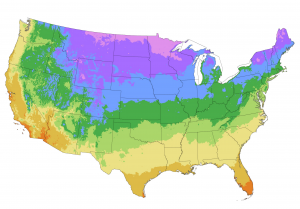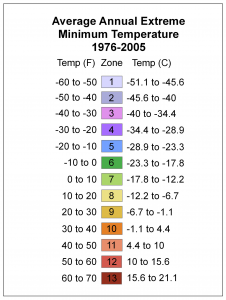Oklahoma Proven: Plant Selections for Oklahoma
- Jump To:
- Introduction
- Annuals
- Perennials
- Shrubs
- Trees
Introduction

Started in 1999, Oklahoma Proven is a plant evaluation and marketing program designed to help consumers select the best plants for their Oklahoma Gardens. The goal has been to select plants that are tolerant of the varied and challenging environmental conditions found throughout Oklahoma, since using well-adapted plants should lead to greater gardening success and more environmentally friendly gardens. Drought resistance has become an important selection criteria for landscape materials, and many of the selections highlighted in this guide are recognized for their low water usage. The following symbols are used to feature special attributes of the plants.
| Icon | Icon Description |
|---|---|
 |
Native: Plant indigenous to the continental U.S. or a cultivar or hybrid derived from native plants. |
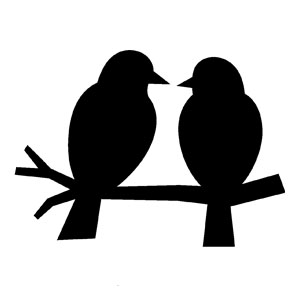 |
Wildscape: Plant possesses one or more characteristics ideal for habitation by birds, butterflies or other animals. |
 |
Drought Resistant: After initial establishment period (up to two years), plant can withstand short-term drought. |
 |
Collector's Choice: This plant will do well in Oklahoma but may need special placement or a little extra care. It will be very rewarding and impressive in the garden. |
The coordinators of the Oklahoma Proven program would like to thank the following for their cooperation and/or financial support:
- Current and Past Executive and Advisory Committee Members
- Department of Horticulture and Landscape Architecture
- Oklahoma Cooperative Extension Service, Oklahoma State University
- Oklahoma Nursery and Landscape Association
- The Botanic Garden at Oklahoma State University
- The City of Oklahoma City Utilities Department
Although the plants presented here are among the best for use in Oklahoma, this is
just a place to start. There are many plants suited for use in Oklahoma and it is
always imperative to match the environmental tolerance of the plant with the environmental
conditions in a particular garden or even a particular spot in the garden.
Oklahoma Proven plants have been selected to withstand environmental stress but remember
that all plants need special attention during the establishment phase or during periods
of environmental extremes.
For more information, visit the Oklahoma Proven website.
Authors: Lou Anella, David Hillock and Mike Schnelle
Editors: Kevin Moore and Justin Quetone Moss
![]()

Annuals
Annual Vinca
Catharanthus roseus
Annual vinca, which also goes by Madagascar periwinkle and other common names. Annual
vinca tolerates the heat and humidity of the southwest. It is tolerant of low  fertility soils and is drought tolerant. Full sun and warm soil temperature is required
for this species to thrive. Annual vinca is subject to chill injury, which predispose
them to root diseases. Avoid planting too early in the spring. Flower colors come
in shades of white, pink, red and purple. Plants grow 6 to 12 inches tall and 8 to
24 inches wide, depending on cultivar. Improved cultivars provide an abundance of
flowers on stocky plants and disease resistance, which is very important with this
species. Improved cultivars include plants in the Cora® series, Mediterranean series,
Titan™ series and many others.
fertility soils and is drought tolerant. Full sun and warm soil temperature is required
for this species to thrive. Annual vinca is subject to chill injury, which predispose
them to root diseases. Avoid planting too early in the spring. Flower colors come
in shades of white, pink, red and purple. Plants grow 6 to 12 inches tall and 8 to
24 inches wide, depending on cultivar. Improved cultivars provide an abundance of
flowers on stocky plants and disease resistance, which is very important with this
species. Improved cultivars include plants in the Cora® series, Mediterranean series,
Titan™ series and many others.
Exposure: Full sun to part shade
Soil: Well drained, slightly dry
Hardiness: Use as annual
| Icon | Icon Description |
|---|---|
 |
Drought resistant: After initial establishment period (up to two years), plant can withstand short-term drought. |
Blanket Flower
Gaillardia
Gaillardia is a genus of native wildflower that has captivated gardeners with its
bright  red and yellow flowers and ability to bloom in hot, dry conditions. The native species,
Gaillardia pulchella, is Oklahoma’s state wildflower and makes an excellent garden
plant. Hybrids (Gaillardia x grandiflora) and new cultivars have been introduced that
expand the color range and form of Gaillardia including: ‘Goblin’ (dwarf form), ‘Fanfare’
(interesting trumpet-shaped flowers around the central disc), ‘Arizona Sun’ (compact
plants with a long period of bloom) and ‘Summer’s Kiss’ (yellow-apricot flowers),
among others. Gaillardia is often a perennial but also reseeds readily, creating drifts
of color in the garden or meadow. Allow the seed heads to dry on the plant for maximum
reseeding and floral display the following summer.
red and yellow flowers and ability to bloom in hot, dry conditions. The native species,
Gaillardia pulchella, is Oklahoma’s state wildflower and makes an excellent garden
plant. Hybrids (Gaillardia x grandiflora) and new cultivars have been introduced that
expand the color range and form of Gaillardia including: ‘Goblin’ (dwarf form), ‘Fanfare’
(interesting trumpet-shaped flowers around the central disc), ‘Arizona Sun’ (compact
plants with a long period of bloom) and ‘Summer’s Kiss’ (yellow-apricot flowers),
among others. Gaillardia is often a perennial but also reseeds readily, creating drifts
of color in the garden or meadow. Allow the seed heads to dry on the plant for maximum
reseeding and floral display the following summer.
Exposure: Full sun
Soil: Well drained
Hardiness: Use as an annual
| Icon | Icon Description |
|---|---|
 |
Native: Plant indigenous to the continental U.S. or a cultivar or hybrid derived from native plants. |
 |
Wildscape: Plant possesses one or more characteristics ideal for habitation by birds, butterflies or other animals. |
Brazilian Verbena (improved cultivars)
Verbena bonariensis 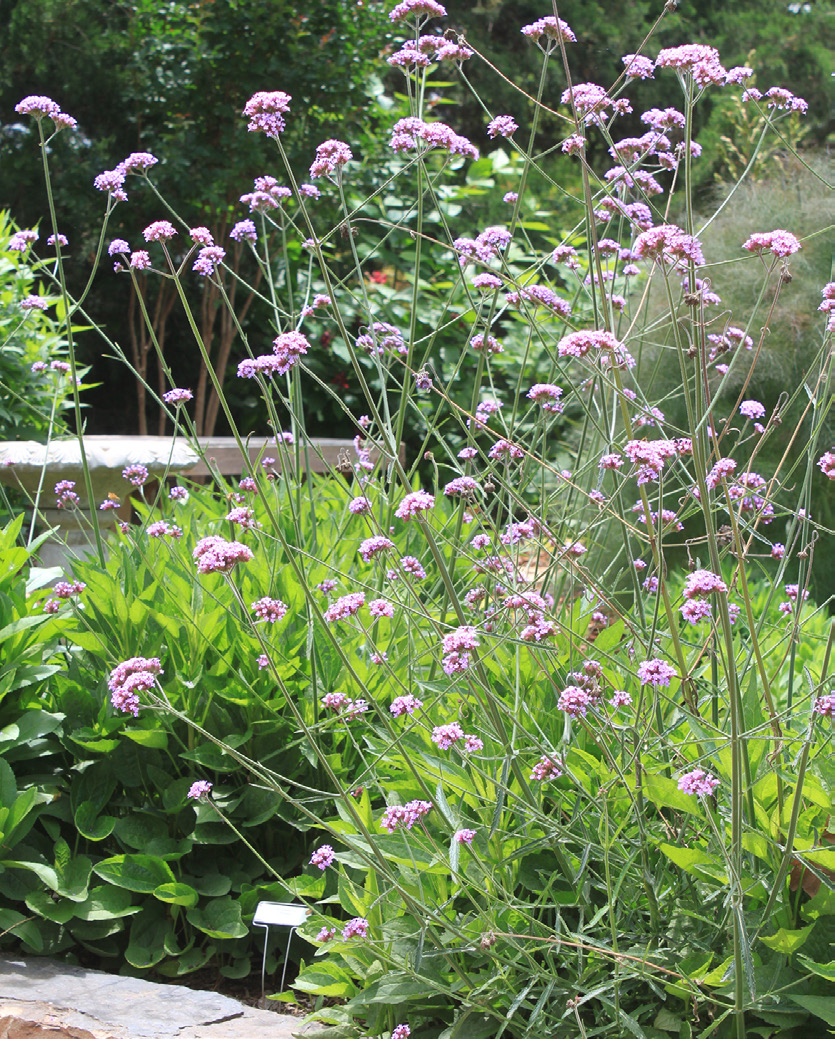
Commonly called Brazilian vervain, this plant is a rapid-growing, clump-forming tender perennial. Plants typically form a 1-foot tall basal clump of dark green leaves from which rise erect, slender, wiry, branching stems to 3.5 feet tall bearing clusters (to 2 inches across) of tiny rose-violet flowers. Though a tender perennial, it often grows as an annual in Oklahoma. If planted in sheltered locations with southern exposures, plants can survive mild winters. Even if plants do not survive winter, they often remain in gardens for a number of years through self-seeding. Plants have no serious insect or disease problems, though watch for powdery mildew. This species is very heat and drought resistant and makes a great cut flower and attracts butterflies and hummingbirds. Improved cultivars include 'Little One,' 'Lollipop' and Meteor Shower®.
Exposure: Full sun/part shade
Soil: Poor soils, good drainage
Hardiness: Use as an annual
| Icon | Icon Description |
|---|---|
 |
Wildscape: Plant possesses one or more characteristics ideal for habitation by birds, butterflies or other animals. |
 |
Drought Resistant: After initial establishment period (up to two years), plant can withstand short-term drought. |
Cape Plumbago
Plumbago auriculata
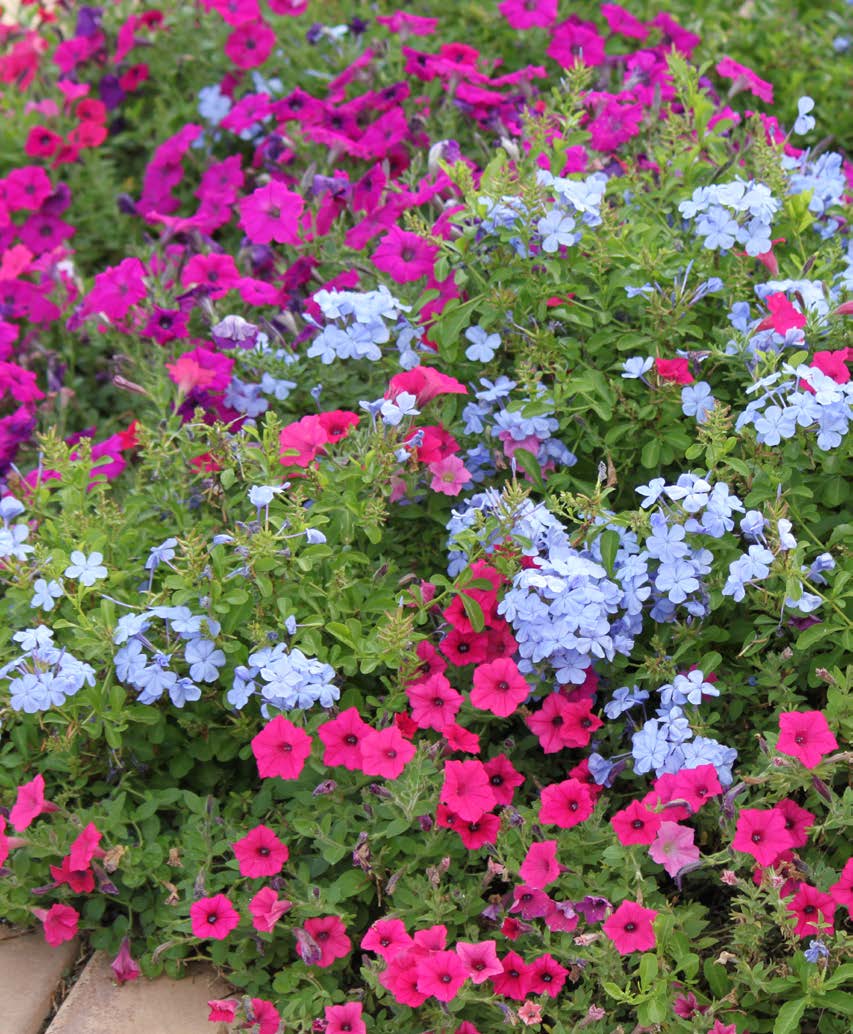 Grows best in organically rich, fertile, well-drained soils in full sun to part shade.
Site in locations protected from strong winds. During the growing season, it does
best in consistently moist soils, but established plants are moderately drought tolerant.
When overwintering as a houseplant, bring indoors before first fall frost to a bright
sunny room. Cut back stems hard in late winter to encourage new growth for the coming
season. When overwintering as a dormant plant in a container, cut stems back and store
in a cool, dry, dark corner of a basement or frost-free garage.
Grows best in organically rich, fertile, well-drained soils in full sun to part shade.
Site in locations protected from strong winds. During the growing season, it does
best in consistently moist soils, but established plants are moderately drought tolerant.
When overwintering as a houseplant, bring indoors before first fall frost to a bright
sunny room. Cut back stems hard in late winter to encourage new growth for the coming
season. When overwintering as a dormant plant in a container, cut stems back and store
in a cool, dry, dark corner of a basement or frost-free garage.
Exposure: Full sun to shade
Soil: Moist, well drained
Hardiness: Use as an annual
| Icon | Icon Description |
|---|---|
 |
Drought resistant: After initial establishment period (up to two years), plant can withstand short-term drought. |
Coleus
Plectranthus scuteleriodes 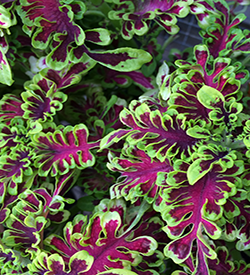
Coleus is a time-honored plant that is quite diverse and full of character. It is well known for its attractive foliage colors, patterns, and forms and has long been a great color plant for shade as well as indoor as a houseplant. Many cultivars are now full sun tolerant and are one of Oklahoma’s best full sun foliage plants. Remove flower spikes as they appear. Pinch plant stem tips to keep plants compact and to promote bushiness. Cultivars range in size from dwarf 6” tall plants to large mounded 36” tall plants. If grown as a houseplant, it requires bright light. Aphids, whiteflies, and spider mites, especially on indoor plants can sometimes be a problem.
Exposure: Full sun to shade
Soil: Moist, well-drained
Hardiness: Use as an annual
Corkscrew Rush
Juncus effusus ‘Big Twister’
Corkscrew rush with its uniquely twisted stems, though relatively small (18 to 24
inches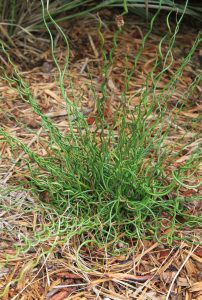 high and wide), still commands attention in any garden space. The stems curl and
spiral, creating a tangled but showy mass. Corkscrew rush grows in full sun or part
shade and prefers moist soils. Happy even submerged in water, it is perfect for a
water garden. Corkscrew rush also is an excellent accent plant for containers. Though
considered hardy to about zone 6, it tends to be more of a tender perennial in our
area. Its annual nature may be due to the dry winters and the drastic temperature
fluctuations often experienced in Oklahoma.
high and wide), still commands attention in any garden space. The stems curl and
spiral, creating a tangled but showy mass. Corkscrew rush grows in full sun or part
shade and prefers moist soils. Happy even submerged in water, it is perfect for a
water garden. Corkscrew rush also is an excellent accent plant for containers. Though
considered hardy to about zone 6, it tends to be more of a tender perennial in our
area. Its annual nature may be due to the dry winters and the drastic temperature
fluctuations often experienced in Oklahoma.
Exposure: Full sun to part shade
Soil: Very moist to wet, acidic
Hardiness: Use as an annual
| Icon | Icon Description |
|---|---|
 |
Native: Plant indigenous to the continental U.S. or a cultivar or hybrid derived from native plants. |
Cuphea (species and cultivars)
Cuphea spp.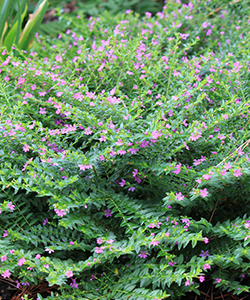
Cuphea is a genus of about 260 plants native to the warm temperate and tropical regions of the Americas. Depending on the species and cultivar, they go by several common names such as firecracker plant, cigar flower, Mexican-heather, bat flower, bunny ears, candy corn plant, and false heather. Cuphea is a tender perennial grown as an annual in Oklahoma. It is low maintenance and it is tolerant to heat and drought. Plant foliage is bright green to blue-green and typically glossy. Although the flowers are small, they are abundant and provide a spectacular show all summer long with no need to deadhead. Plants come in a variety of forms with a variety of flower colors and forms that are vivid and produce a sweet nectar that attracts hummingbirds, butterflies, and other pollinators.
Exposure: Full sun
Soil: Moist, well-drained; tolerates drier soil after establishment
Hardiness: Use as an annual
| Icon | Icon Description |
|---|---|
 |
Wildscape: Plant possesses one or more characteristics ideal for habitation by birds, butterflies or other animals. |
 |
Drought Resistant: After initial establishment period (up to two years), plant can withstand short-term drought. |
Dakota Gold Sneezeweed
Helenium ‘Dakota Gold’
Common names for Helenium include sneezeweed and bitterweed. It is a native  wildflower of Oklahoma. ‘Dakota Gold’ is a cultivar with excellent ornamental qualities
that is also very tough and tolerates heat and dry conditions. ‘Dakota Gold’ grows
as low, 6- to 8-inch mounded cushions of fine, dark green foliage covered with golden
yellow flowers all summer long. ‘Dakota Gold’ looks great in beds, containers, rock
gardens, borders and as an accent.
wildflower of Oklahoma. ‘Dakota Gold’ is a cultivar with excellent ornamental qualities
that is also very tough and tolerates heat and dry conditions. ‘Dakota Gold’ grows
as low, 6- to 8-inch mounded cushions of fine, dark green foliage covered with golden
yellow flowers all summer long. ‘Dakota Gold’ looks great in beds, containers, rock
gardens, borders and as an accent.
Exposure: Full sun
Soil: Well drained
Hardiness: Use as an annual
| Icon | Icon Description |
|---|---|
 |
Native: Plant indigenous to the continental U.S. or a cultivar or hybrid derived from native plants. |
 |
Wildscape: Plant possesses one or more characteristics ideal for habitation by birds, butterflies or other animals. |
 |
Drought Resistant: After initial establishment period (up to two years), plant can withstand short-term drought. |
Diamond Frost® Euphorbia
Euphorbia ‘Inneuphdia’
Diamond Frost® euphorbia is a fine-textured mounding plant used as an annual in 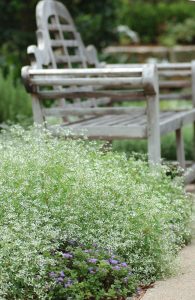 Oklahoma. The simple white flowers bloom from spring until first frost and the plant
forms a 2- to 3-foot sphere. Diamond Frost® can be used as a mass planting, alone in a container or mixed with almost any other
plant. Its fine sprays of foliage and flowers will weave through other plants, making
it a perfect complement for almost anything from poinsettias to petunias. It is an
excellent background plant, filler or specimen, proving to be an extremely beautiful
and versatile introduction.
Oklahoma. The simple white flowers bloom from spring until first frost and the plant
forms a 2- to 3-foot sphere. Diamond Frost® can be used as a mass planting, alone in a container or mixed with almost any other
plant. Its fine sprays of foliage and flowers will weave through other plants, making
it a perfect complement for almost anything from poinsettias to petunias. It is an
excellent background plant, filler or specimen, proving to be an extremely beautiful
and versatile introduction.
Exposure: Full sun to part shade
Soil: Moist, well drained
Hardiness: Use as an annual
| Icon | Icon Description |
|---|---|
 |
Drought Resistant: After initial establishment period (up to two years), plant can withstand short-term drought. |
Fan Flower
Scaevola aemula
Fan flower is an evergreen tropical used as an  annual in temperate climates. This low-growing plant carpets the ground with flowers
all season long when grown in full sun. Its primary flower colors are pink, yellow,
lavender and white. It prefers a moist, well-drained soil but is quite drought tolerant
once established. Dwarf and standard sizes are available.
annual in temperate climates. This low-growing plant carpets the ground with flowers
all season long when grown in full sun. Its primary flower colors are pink, yellow,
lavender and white. It prefers a moist, well-drained soil but is quite drought tolerant
once established. Dwarf and standard sizes are available.
Exposure: Full sun
Soil: Moist, well drained
Hardiness: Use as an annual
| Icon | Icon Description |
|---|---|
 |
Drought Resistant: After initial establishment period (up to two years), plant can withstand short-term drought. |
Firebush
Hamelia patens
This Central and South American native is a small tree when grown 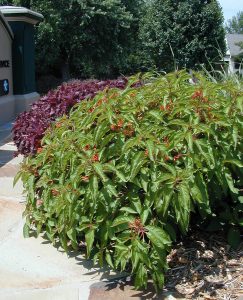 in the Deep South, but is best used as a heat-tolerant annual in Oklahoma. The lush
green foliage can produce a dense mound over 3 feet high in full sun. Color is added
by the interesting orange-red flowers and the reddish tinge on the leaf petioles.
Firebush thrives in the summer heat and attracts hummingbirds and butterflies to the
garden.
in the Deep South, but is best used as a heat-tolerant annual in Oklahoma. The lush
green foliage can produce a dense mound over 3 feet high in full sun. Color is added
by the interesting orange-red flowers and the reddish tinge on the leaf petioles.
Firebush thrives in the summer heat and attracts hummingbirds and butterflies to the
garden.
Exposure: Full sun
Soil: Well drained
Hardiness: Use as an annual
| Icon | Icon Description |
|---|---|
 |
Wildscape: Plant possesses one or more characteristics ideal for habitation by birds, butterflies or other animals. |
 |
Drought Resistant: After initial establishment period (up to two years), plant can withstand short-term drought. |
Firecracker Flower
Crossandra infundibuliformis
Firecracker flower is native to India and Sri Lanka, where it is a tropical evergreen
subshrub that grows 1 to 3 feet tall. Flowers are apricot to salmon pink in color
and 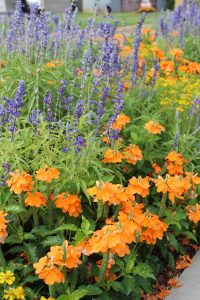 form in terminal racemes. Yellow- and red-flowered forms are also available. Plants
bloom throughout the summer and attract pollinators. Leaves of firecracker flower
are shiny dark green. ‘Orange Marmalade’ has long-lasting blooms on a plant that thrives
with heat and humidity. Large clusters of frilly, bright orange flowers shine against
the glossy green foliage. Firecracker flower prefers light, organically rich, medium
moisture, well-drained soils in full sun or part shade, but will tolerate a bright
full shade area. Plants thrive in warm, humid weather and have no serious insect or
disease problems. Firecracker flower is beautiful in beds, borders, containers or
as a houseplant.
form in terminal racemes. Yellow- and red-flowered forms are also available. Plants
bloom throughout the summer and attract pollinators. Leaves of firecracker flower
are shiny dark green. ‘Orange Marmalade’ has long-lasting blooms on a plant that thrives
with heat and humidity. Large clusters of frilly, bright orange flowers shine against
the glossy green foliage. Firecracker flower prefers light, organically rich, medium
moisture, well-drained soils in full sun or part shade, but will tolerate a bright
full shade area. Plants thrive in warm, humid weather and have no serious insect or
disease problems. Firecracker flower is beautiful in beds, borders, containers or
as a houseplant.
Exposure: Full sun to part shade
Soil: Moist, well drained
Hardiness: Use as an annual
Magilla™ Perilla
Perilla frutescens
Known for its brightly colored leaves of dark purple to hot pink and green, 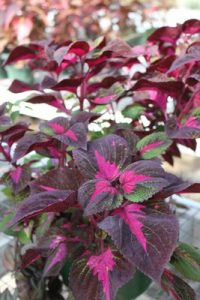 Magilla™perilla is a vigorous annual. Magilla™ perilla is a coleus look-alike, is
in the same family as coleus, and has similar characteristics and growing needs. The
species, Perilla frutescens, can be weedy, but Magilla™ is well behaved due to sterile
seeds. It grows into a 24-inch tall mound and is heat tolerant. Magilla™ perilla looks
great in beds, mixed borders and is spectacular in a container planting.
Magilla™perilla is a vigorous annual. Magilla™ perilla is a coleus look-alike, is
in the same family as coleus, and has similar characteristics and growing needs. The
species, Perilla frutescens, can be weedy, but Magilla™ is well behaved due to sterile
seeds. It grows into a 24-inch tall mound and is heat tolerant. Magilla™ perilla looks
great in beds, mixed borders and is spectacular in a container planting.
Exposure: Full sun to part shade
Soil: Moist, well drained
Hardiness: Use as an annual
Margarita Sweet Potato
Ipomoea batatas ‘Margarita’
Margarita sweet potato is a spreading vine with chartreuse  leaves. It is excellent as a ground cover or as a potted plant. This striking cultivar
tolerates full sun to partial shade and can grow to 8 inches tall and 20 feet long.
It is shown here with fan flower and purple fountain grass, other Oklahoma Proven
selections.
leaves. It is excellent as a ground cover or as a potted plant. This striking cultivar
tolerates full sun to partial shade and can grow to 8 inches tall and 20 feet long.
It is shown here with fan flower and purple fountain grass, other Oklahoma Proven
selections.
Exposure: Full sun to part shade
Soil: Well drained
Hardiness: Use as an annual
| Icon | Icon Description |
|---|---|
 |
Drought Resistant: After initial establishment period (up to two years), plant can withstand short-term drought. |
Mexican Zinnia
Zinnia angustifolia
Several cultivars of Mexican zinnia are available with  white, yellow, pink or orange flowers that bloom all summer. All thrive in the heat,
are mildew resistant and make excellent 1-foot-tall compact plants for containers,
bedding or edging.
white, yellow, pink or orange flowers that bloom all summer. All thrive in the heat,
are mildew resistant and make excellent 1-foot-tall compact plants for containers,
bedding or edging.
Exposure: Full sun
Soil: Well drained
Hardiness: Use as an annual
| Icon | Icon Description |
|---|---|
 |
Native: Plant indigenous to the continental U.S. or a cultivar or hybrid derived from native plants. |
 |
Wildscape: Plant possesses one or more characteristics ideal for habitation by birds, butterflies or other animals. |
 |
Drought Resistant: After initial establishment period (up to two years), plant can withstand short-term drought. |
0Pink Crystals Ruby Grass
Melinis nerviglumis ‘Savannah’
Pink crystals ruby grass is a warm-season grass that likes it hot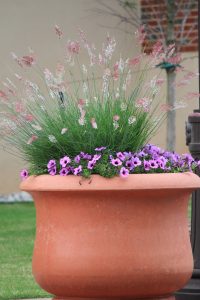 and performs best in those conditions. Growing only 18 to 22 inches tall, it is an
attractive ornamental grass with blue-green foliage and ruby-pink blooms with glistening
silky hairs in late spring. Flowers retain their color even when dried and may be
used for cut flower arrangements. Pink crystals ruby grass is excellent in beds, borders
and is spectacular in a container planting.
and performs best in those conditions. Growing only 18 to 22 inches tall, it is an
attractive ornamental grass with blue-green foliage and ruby-pink blooms with glistening
silky hairs in late spring. Flowers retain their color even when dried and may be
used for cut flower arrangements. Pink crystals ruby grass is excellent in beds, borders
and is spectacular in a container planting.
Exposure: Full sun to part shade
Soil: Well drained
Hardiness: Use as an annual
0Profusion Red Yellow Bicolor Zinnia
Zinnia hybrida
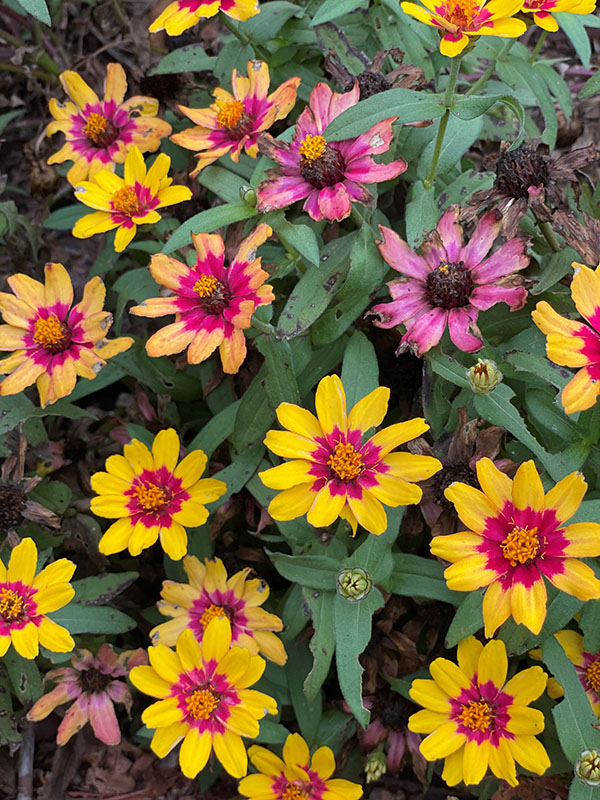 This gorgeous zinnia starts the season with a bold vibrant red center ring surrounded
by golden-yellow outer petals. As the season progresses, the aging flowers morph into
soft, beautiful shades of apricot, salmon and dusty rose to bring a plethora of color
to the garden, all from one variety! Trial garden visitors clamored over this floriferous
and compact plant during the summer trials noting how well the plant continued to
bloom new flowers over old so there was never a decline in the beauty presented by
Profusion Red Yellow Bicolor. Does well in well-drained soil and is disease tolerant.
Attracts pollinators. Profusion Red Yellow Bicolor is also the recipient of the Fleuroselect
Gold Medal award for performance in European trials.
This gorgeous zinnia starts the season with a bold vibrant red center ring surrounded
by golden-yellow outer petals. As the season progresses, the aging flowers morph into
soft, beautiful shades of apricot, salmon and dusty rose to bring a plethora of color
to the garden, all from one variety! Trial garden visitors clamored over this floriferous
and compact plant during the summer trials noting how well the plant continued to
bloom new flowers over old so there was never a decline in the beauty presented by
Profusion Red Yellow Bicolor. Does well in well-drained soil and is disease tolerant.
Attracts pollinators. Profusion Red Yellow Bicolor is also the recipient of the Fleuroselect
Gold Medal award for performance in European trials.
Exposure: Full sun, part shade
Soil: Moist, well-drained
Hardiness: Use as an annual
| Icon | Icon Description |
|---|---|
 |
Wildscape: Plant possesses one or more characteristics ideal for habitation by birds, butterflies or other animals. |
Purple Fountain Grass
Pennisetum setaceum ‘Rubrum’
Growing 3 to 4 feet high, this heat- and drought-tolerant plant blooms all 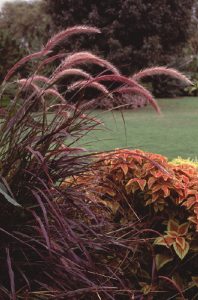 summer until frost. It provides a dramatic accent in sunny beds and borders. It has
purple leaves and bristled flower spikes, providing color and texture throughout the
season.
summer until frost. It provides a dramatic accent in sunny beds and borders. It has
purple leaves and bristled flower spikes, providing color and texture throughout the
season.
Exposure: Full sun
Soil: Moist, well drained
Hardiness: Use as an annual
| Icon | Icon Description |
|---|---|
 |
Drought Resistant: After initial establishment period (up to two years), plant can withstand short-term drought. |
Silver Falls Dichondra
Dichondra argentea ‘Silver Falls’
‘Silver Falls’ dichondra was selected for its very low-growing, creeping, trailing
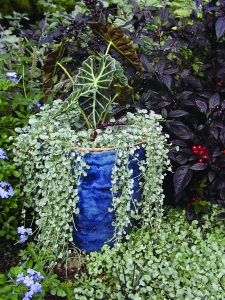 habit and beautiful silvery gray leaves that are shaped like miniature lily pads.
‘Silver Falls’ is actually a selection of a dichondra species native to southwest
Texas and Mexico, so it is quite heat and drought tolerant. Growing only 2 inches
tall and 3 to 4 feet wide, it is an attractive groundcover, but is also spectacular
in a container planting or hanging basket, spilling over a retaining wall or when
used in a rock garden.
habit and beautiful silvery gray leaves that are shaped like miniature lily pads.
‘Silver Falls’ is actually a selection of a dichondra species native to southwest
Texas and Mexico, so it is quite heat and drought tolerant. Growing only 2 inches
tall and 3 to 4 feet wide, it is an attractive groundcover, but is also spectacular
in a container planting or hanging basket, spilling over a retaining wall or when
used in a rock garden.
Exposure: Full sun to part shade
Soil: Well drained
Hardiness: Use as an annual
| Icon | Icon Description |
|---|---|
 |
Native: Plant indigenous to the continental U.S. or a cultivar or hybrid derived from native plants. |
 |
Wildscape: Plant possesses one or more characteristics ideal for habitation by birds, butterflies or other animals. |
 |
Drought Resistant: After initial establishment period (up to two years), plant can withstand short-term drought. |
Spider Flower
Cleome hybrids
Spider flower is a unique plant with palmately compound leaves, and interesting, 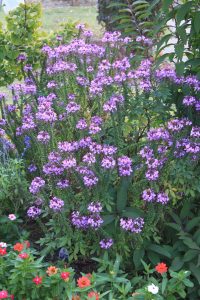 fragrant flowers with an old-fashion look. Flowers have abnormally long stamens that
give the flower a frilly look and is likely where the common name of spider flower
comes from, since they resemble spider legs. Flower colors come in shades of white,
pink and purple. Plants can grow 3 to 6 feet tall, depending on cultivar. Improved
cultivars provide an abundance of flowers on stocky plants. Improved cultivars include
plants in the Sparkler™ series; the Spirit™ series; Senorita Rosalita® (vivid pink blooms); and Senorita Blanca® (white blooms with pale lavender blush). Spider flowers attracts butterflies and
hummingbirds and goes well with a cottage style, wildflower design or mixed border.
fragrant flowers with an old-fashion look. Flowers have abnormally long stamens that
give the flower a frilly look and is likely where the common name of spider flower
comes from, since they resemble spider legs. Flower colors come in shades of white,
pink and purple. Plants can grow 3 to 6 feet tall, depending on cultivar. Improved
cultivars provide an abundance of flowers on stocky plants. Improved cultivars include
plants in the Sparkler™ series; the Spirit™ series; Senorita Rosalita® (vivid pink blooms); and Senorita Blanca® (white blooms with pale lavender blush). Spider flowers attracts butterflies and
hummingbirds and goes well with a cottage style, wildflower design or mixed border.
Exposure: Full sun to part shade
Soil: Moist, well drained
Hardiness: Use as an annual
| Icon | Icon Description |
|---|---|
 |
Drought Resistant: After initial establishment period (up to two years), plant can withstand short-term drought. |
Spilanthes
Acmella oleracea ‘Peek-A-Boo’
‘Peek-A-Boo’ spilanthes was selected for its yellow flowers, each with a red eye 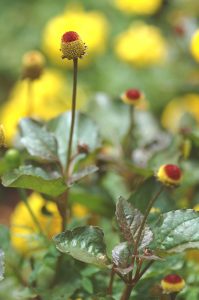 poking up out of the foliage. The green foliage has a purple tinge in full sun, turning
more purple as fall approaches. The foliage can be used in salads or cooked as a green.
Spilanthes is also known as the toothache plant because it has been used to numb pain.
In the garden, it is a great conversation piece when combined with other plants in
a mixed container or it can be used as a flowering groundcover. It grows 12 to 15
inches tall and spreads 24 to 30 inches.
poking up out of the foliage. The green foliage has a purple tinge in full sun, turning
more purple as fall approaches. The foliage can be used in salads or cooked as a green.
Spilanthes is also known as the toothache plant because it has been used to numb pain.
In the garden, it is a great conversation piece when combined with other plants in
a mixed container or it can be used as a flowering groundcover. It grows 12 to 15
inches tall and spreads 24 to 30 inches.
Exposure: Full sun to part shade
Soil: Moist, well drained
Hardiness: Use as an annual
Star Flower, Graffiti® Series
Pentas lanceolata
Considered to be the most uniform in habit as well as bloom time, Graffiti® comes in several colors including pink, purple, bright red, rose and white. It grows
to 16 inches  high and 12 inches wide, making it a great plant for containers or in a flower bed.
Graffiti® plants are very heat- and drought-resistant and make great cut flowers. With its
tightly clustered flowers that sit above the foliage in bright colors that have an
abundance of nectar, Graffiti® pentas are a sure attractant for butterflies and hummingbirds throughout the summer
months. Like all pentas, Graffiti® prefers soil that is not too rich; if it’s a bit on the dry side, all the better.
Heat, sun and good drainage will have the plants blooming heartily all summer long.
high and 12 inches wide, making it a great plant for containers or in a flower bed.
Graffiti® plants are very heat- and drought-resistant and make great cut flowers. With its
tightly clustered flowers that sit above the foliage in bright colors that have an
abundance of nectar, Graffiti® pentas are a sure attractant for butterflies and hummingbirds throughout the summer
months. Like all pentas, Graffiti® prefers soil that is not too rich; if it’s a bit on the dry side, all the better.
Heat, sun and good drainage will have the plants blooming heartily all summer long.
Exposure: Full sun to part shade
Soil: Moderately moist, well drained
Hardiness: Use as an annual
| Icon | Icon Description |
|---|---|
 |
Wildscape: Plant possesses one or more characteristics ideal for habitation by birds, butterflies or other animals. |
 |
Drought Resistant: After initial establishment period (up to two years), plant can withstand short-term drought. |
Summer Snapdragon
Angelonia angustifolia
Summer snapdragon is a tropical subshrub that can be used as an annual in 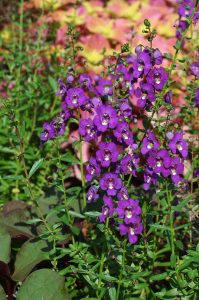 Oklahoma and will bloom from summer until the first frost. Orchid-like flowers are
produced on 2-foot-tall spikes. Depending on cultivar, flower color ranges from blue
to purple, pink or white, with bicolor forms also available. Summer snapdragon may
be used as a bedding plant, to add color to a mixed border or in a container. It is
drought tolerant and loves full sun and summer heat.
Oklahoma and will bloom from summer until the first frost. Orchid-like flowers are
produced on 2-foot-tall spikes. Depending on cultivar, flower color ranges from blue
to purple, pink or white, with bicolor forms also available. Summer snapdragon may
be used as a bedding plant, to add color to a mixed border or in a container. It is
drought tolerant and loves full sun and summer heat.
Exposure: Full sun
Soil: Well drained
Hardiness: Use as an annual
| Icon | Icon Description |
|---|---|
 |
Drought Resistant: After initial establishment period (up to two years), plant can withstand short-term drought. |
Supertunia® Vista Bubblegum® Petunia
Petunia ‘Ustuni6001’
Supertunia® Vista Bubblegum® is a vigorous petunia that requires very little care once established. Unlike some
other petunias, Vista Bubblegum® is a self-dead-heading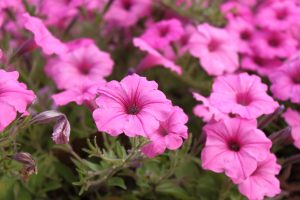 variety that blooms continuously until the first killing frost. With its bright bubblegum
pink flowers, Vista Bubblegum® is a mounding, trailing form that grows to 18 to 24 inches high and just as wide.
It looks spectacular spilling over the edge of a container or retaining wall, or spreading
out in a flower bed. For the most vigorous plants, fertilize them with a slow-release
fertilizer at planting, then follow up throughout the summer with a water-soluble
fertilizer applied when watering. Even though no dead-heading is needed, Vista Bubblegum® responds well to a light trimming in early July.
variety that blooms continuously until the first killing frost. With its bright bubblegum
pink flowers, Vista Bubblegum® is a mounding, trailing form that grows to 18 to 24 inches high and just as wide.
It looks spectacular spilling over the edge of a container or retaining wall, or spreading
out in a flower bed. For the most vigorous plants, fertilize them with a slow-release
fertilizer at planting, then follow up throughout the summer with a water-soluble
fertilizer applied when watering. Even though no dead-heading is needed, Vista Bubblegum® responds well to a light trimming in early July.
Exposure: Full sun to part shade
Soil: Moist, well drained
Hardiness: Use as an annual
Wishbone Flower Summer Wave® Series
Torenia
The Summer Wave® series is a collection of hybrid Torenia, or wishbone flower, that 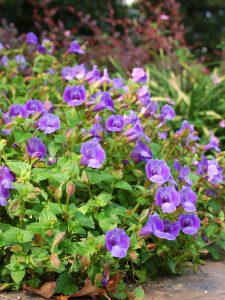 thrive in the summer heat. The plants form a mound that is 6 inches high and 12 inches
wide that is great for the border, in a pot or mixed with other plants in a larger
container. The Summer Wave® series is comprised of the following cultivars: ‘Amethyst,’ ‘Blue,’ ‘Large Violet’
and ‘Lavender Blue.’ Each produces flowers from spring until fall, and each flower
has a wishbone shape at its center, thus the name.
thrive in the summer heat. The plants form a mound that is 6 inches high and 12 inches
wide that is great for the border, in a pot or mixed with other plants in a larger
container. The Summer Wave® series is comprised of the following cultivars: ‘Amethyst,’ ‘Blue,’ ‘Large Violet’
and ‘Lavender Blue.’ Each produces flowers from spring until fall, and each flower
has a wishbone shape at its center, thus the name.
Exposure: Partial shade
Soil: Moist, well drained
Hardiness: Use as an annual
Yellow Bells
Tecoma stans
 Yellow bells is a tropical shrub used as an annual in Oklahoma. It can reach a height
of 3 feet and produces striking yellow flowers above glossy green leaves from summer
until frost. Give this plant a southern exposure; it loves the heat and sun.
Yellow bells is a tropical shrub used as an annual in Oklahoma. It can reach a height
of 3 feet and produces striking yellow flowers above glossy green leaves from summer
until frost. Give this plant a southern exposure; it loves the heat and sun.
Exposure: Full sun
Soil: Moist, well drained
Hardiness: Use as an annual
Perennials
Anise Hyssop
Agastache foeniculum ‘Golden Jubilee’
‘Golden Jubilee’ is a cultivar of the North American native commonly known as anise
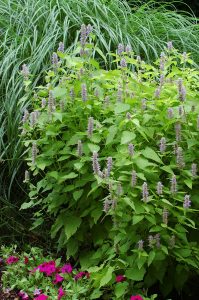 hyssop. It was selected for its chartreuse foliage, was named to commemorate HM Queen
Elizabeth II’s golden jubilee and was the 2003 All-America Selections flower award
winner. Reaching 2 feet tall and 1 foot wide, ‘Golden Jubilee’ produces light purple
flower spikes from early summer to fall. Although a perennial, it will reseed in the
garden and new plants also will be golden. As an added bonus, brushing against the
foliage releases the plant’s licorice scent.
hyssop. It was selected for its chartreuse foliage, was named to commemorate HM Queen
Elizabeth II’s golden jubilee and was the 2003 All-America Selections flower award
winner. Reaching 2 feet tall and 1 foot wide, ‘Golden Jubilee’ produces light purple
flower spikes from early summer to fall. Although a perennial, it will reseed in the
garden and new plants also will be golden. As an added bonus, brushing against the
foliage releases the plant’s licorice scent.
Exposure: Full sun
Soil: Moist, well drained
Hardiness: USDA Zone 6
| Icon | Icon Description |
|---|---|
 |
Native: Plant indigenous to the continental U.S. or a cultivar or hybrid derived from native plants. |
 |
Wildscape: Plant possesses one or more characteristics ideal for habitation by birds, butterflies or other animals. |
 |
Drought Resistant: After initial establishment period (up to two years), plant can withstand short-term drought. |
Arkansas Bluestar
Amsonia hubrichtii
Arkansas bluestar is native to eastern Oklahoma and Arkansas, but does well 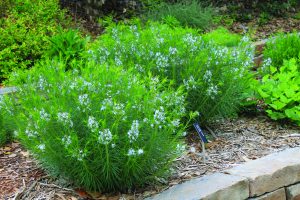 throughout the state. It is tolerant of moist soils and is quite drought tolerant
once established. Flowers are sky blue, star-shaped and develop in clusters at the
end of each branch in early spring. Leaves are needle-like on upright stems that sway
in the breeze, providing a soft, wispy appearance. Foliage is bright green in summer
and then seemingly overnight in fall, it explodes to a golden yellow. Amsonia grows
to 3 feet high. Plant in masses for best effect. Can be used in mixed borders, meadows,
native gardens and open woods.
throughout the state. It is tolerant of moist soils and is quite drought tolerant
once established. Flowers are sky blue, star-shaped and develop in clusters at the
end of each branch in early spring. Leaves are needle-like on upright stems that sway
in the breeze, providing a soft, wispy appearance. Foliage is bright green in summer
and then seemingly overnight in fall, it explodes to a golden yellow. Amsonia grows
to 3 feet high. Plant in masses for best effect. Can be used in mixed borders, meadows,
native gardens and open woods.
Exposure: Full sun to part shade
Soil: Dry to moist, well drained
Hardiness: USDA Zones 4 to 9
| Icon | Icon Description |
|---|---|
 |
Native: Plant indigenous to the continental U.S. or a cultivar or hybrid derived from native plants. |
 |
Wildscape: Plant possesses one or more characteristics ideal for habitation by birds, butterflies or other animals. |
 |
Drought Resistant: After initial establishment period (up to two years), plant can withstand short-term drought. |
Autumn Sage
Salvia greggii ‘Pink Preference’
‘Pink Preference’ is a cultivar of autumn sage that was selected for its bright pink
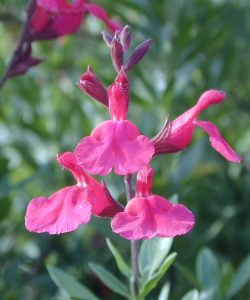 flowers. Like the species, it is a heat- and drought-tolerant perennial that starts
blooming in the spring, but blooms most in the autumn as other flowers in the garden
start to fade. It forms a 2- to 3-foot mound and attracts hummingbirds and butterflies
to the garden. Pruning to 6 inches high each spring will help keep autumn sage dense
and full.
flowers. Like the species, it is a heat- and drought-tolerant perennial that starts
blooming in the spring, but blooms most in the autumn as other flowers in the garden
start to fade. It forms a 2- to 3-foot mound and attracts hummingbirds and butterflies
to the garden. Pruning to 6 inches high each spring will help keep autumn sage dense
and full.
Exposure: Full sun
Soil: Well drained
Hardiness: USDA Zone 6
| Icon | Icon Description |
|---|---|
 |
Native: Plant indigenous to the continental U.S. or a cultivar or hybrid derived from native plants. |
 |
Wildscape: Plant possesses one or more characteristics ideal for habitation by birds, butterflies or other animals. |
 |
Drought Resistant: After initial establishment period (up to two years), plant can withstand short-term drought. |
Catmint
Nepeta x faassenii ‘Walker’s Low’
‘Walker’s Low’ catmint was the Perennial Plant of the Year in 2007 and is an easy-to-grow,
pest-free perennial. This hybrid Nepeta develops into a mound of aromatic, grayish-green foliage. Lavender-blue flowers appear in spring and continue to bloom
if properly pruned by trimming after initial flowering. ‘Walker’s Low’ grows 1 to
2 feet high and 1 ½ to 3 feet wide and can be used as edging or in a border, herb
or rock garden, naturalized area, as groundcover or is quite attractive spilling over
the edge of a wall. Nepeta attracts bees and butterflies. It also tolerates some shade;
dry, rocky soil; and is quite drought and deer resistant.
grayish-green foliage. Lavender-blue flowers appear in spring and continue to bloom
if properly pruned by trimming after initial flowering. ‘Walker’s Low’ grows 1 to
2 feet high and 1 ½ to 3 feet wide and can be used as edging or in a border, herb
or rock garden, naturalized area, as groundcover or is quite attractive spilling over
the edge of a wall. Nepeta attracts bees and butterflies. It also tolerates some shade;
dry, rocky soil; and is quite drought and deer resistant.
Exposure: Full sun to part shade
Soil: Moist, well drained
Hardiness: USDA Zones 3 to 8
| Icon | Icon Description |
|---|---|
 |
Wildscape: Plant possesses one or more characteristics ideal for habitation by birds, butterflies or other animals. |
 |
Drought Resistant: After initial establishment period (up to two years), plant can withstand short-term drought. |
Coral Bells or Alum Root
Heuchera cultivars 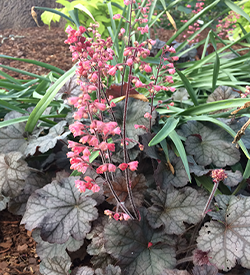
Coral bells are a versatile perennial with attractive foliage and bell-shaped flowers native to North America. Foliage comes in an array of colors and forms and are evergreen to semi-evergreen, depending on winter temperatures, often providing interest year-round. The leaves are the real show of this plant, and in addition to the many colors they come in, some have marbled patterns, dramatic veining, silverly overlays, and ruffled edges. Flowers are produced on wiry stems above the foliage in the spring to early summer. Flower colors can range from pink to red and white and are favored by butterflies and bees. It prefers fertile, moist soil but is quite drought tolerant once established; however, due to shallow roots, water during dry spells. Avoid wet, soggy soils particularly in winter.
Exposure: Full sun/part shade
Soil: Moist, well drained
Hardiness: USDA Zone 4 to 9
| Icon | Icon Description |
|---|---|
 |
Native: Plant indigenous to the continental U.S. or a cultivar or hybrid derived from native plants. |
 |
Wildscape: Plant possesses one or more characteristics ideal for habitation by birds, butterflies or other animals. |
 |
Drought Resistant: After initial establishment period (up to two years), plant can withstand short-term drought. |
Evening Primrose
Oenothera macrocarpa ‘Comanche Campfire’
This species of evening primrose is native to western Oklahoma and ‘Comanche 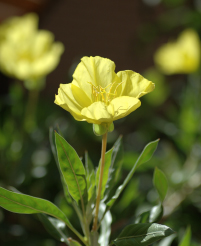 Campfire’ was selected for its ability to produce beautiful yellow flowers above red
petioles and silver foliage. It is touted as a xeriscape perennial since it thrives
in well-drained soil and, once established, requires little moisture. As a low-growing,
clumping perennial, ‘Comanche Campfire’ reaches a height of 15 to 18 inches and spreads
to 2 feet. Use it in a rock garden or along the edge of a perennial bed.
Campfire’ was selected for its ability to produce beautiful yellow flowers above red
petioles and silver foliage. It is touted as a xeriscape perennial since it thrives
in well-drained soil and, once established, requires little moisture. As a low-growing,
clumping perennial, ‘Comanche Campfire’ reaches a height of 15 to 18 inches and spreads
to 2 feet. Use it in a rock garden or along the edge of a perennial bed.
Exposure: Full sun
Soil: Well drained
Hardiness: USDA Zone 4
| Icon | Icon Description |
|---|---|
 |
Native: Plant indigenous to the continental U.S. or a cultivar or hybrid derived from native plants. |
 |
Wildscape: Plant possesses one or more characteristics ideal for habitation by birds, butterflies or other animals. |
 |
Drought Resistant: After initial establishment period (up to two years), plant can withstand short-term drought. |
Gaura
Gaura lindheimeri ‘Siskiyou Pink’
Gaura is a drought-tolerant perennial that thrives in the heat 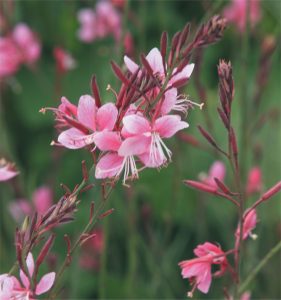 and humidity of the South. Although the species produces white flowers, the cultivar
‘Siskiyou Pink’ has bright pink flowers that appear on airy, 3- to 4-foot-tall sprays
early in the spring. Blooming will continue until fall if old flower spikes are removed.
and humidity of the South. Although the species produces white flowers, the cultivar
‘Siskiyou Pink’ has bright pink flowers that appear on airy, 3- to 4-foot-tall sprays
early in the spring. Blooming will continue until fall if old flower spikes are removed.
Exposure: Full sun to part shade
Soil: Well drained
Hardiness: USDA Zone 5
| Icon | Icon Description |
|---|---|
 |
Native: Plant indigenous to the continental U.S. or a cultivar or hybrid derived from native plants. |
 |
Wildscape: Plant possesses one or more characteristics ideal for habitation by birds, butterflies or other animals. |
 |
Drought Resistant: After initial establishment period (up to two years), plant can withstand short-term drought. |
Giant Coneflower
Rudbeckia maxima
Giant coneflower is native to eastern Oklahoma, but does well throughout the state.
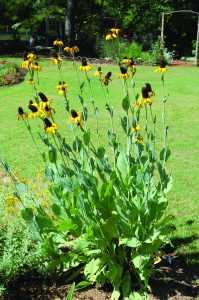 It is tolerant of moist soils and is quite drought tolerant once established. Giant
coneflower has waxy, silvery-blue foliage. Flowers have bright yellow ray flowers
that dangle from a large, upright, dark brown cone on stems that reach 5 to 6 feet
high. Giant coneflower blooms in early summer but dead-heading the spent blossoms
will encourage another flush of blooms in late summer. Plant in masses for best effect.
Can be used in mixed borders, meadows, native gardens and open woods. This species
makes a strong vertical statement in the landscape.
It is tolerant of moist soils and is quite drought tolerant once established. Giant
coneflower has waxy, silvery-blue foliage. Flowers have bright yellow ray flowers
that dangle from a large, upright, dark brown cone on stems that reach 5 to 6 feet
high. Giant coneflower blooms in early summer but dead-heading the spent blossoms
will encourage another flush of blooms in late summer. Plant in masses for best effect.
Can be used in mixed borders, meadows, native gardens and open woods. This species
makes a strong vertical statement in the landscape.
Exposure: Full sun to part shade
Soil: Moist, well drained
Hardiness: USDA Zones 4 to 8
| Icon | Icon Description |
|---|---|
 |
Native: Plant indigenous to the continental U.S. or a cultivar or hybrid derived from native plants. |
 |
Wildscape: Plant possesses one or more characteristics ideal for habitation by birds, butterflies or other animals. |
 |
Drought Resistant: After initial establishment period (up to two years), plant can withstand short-term drought. |
Golden Variegated Sweet Flag
Acorus gramineus 'Ogon' 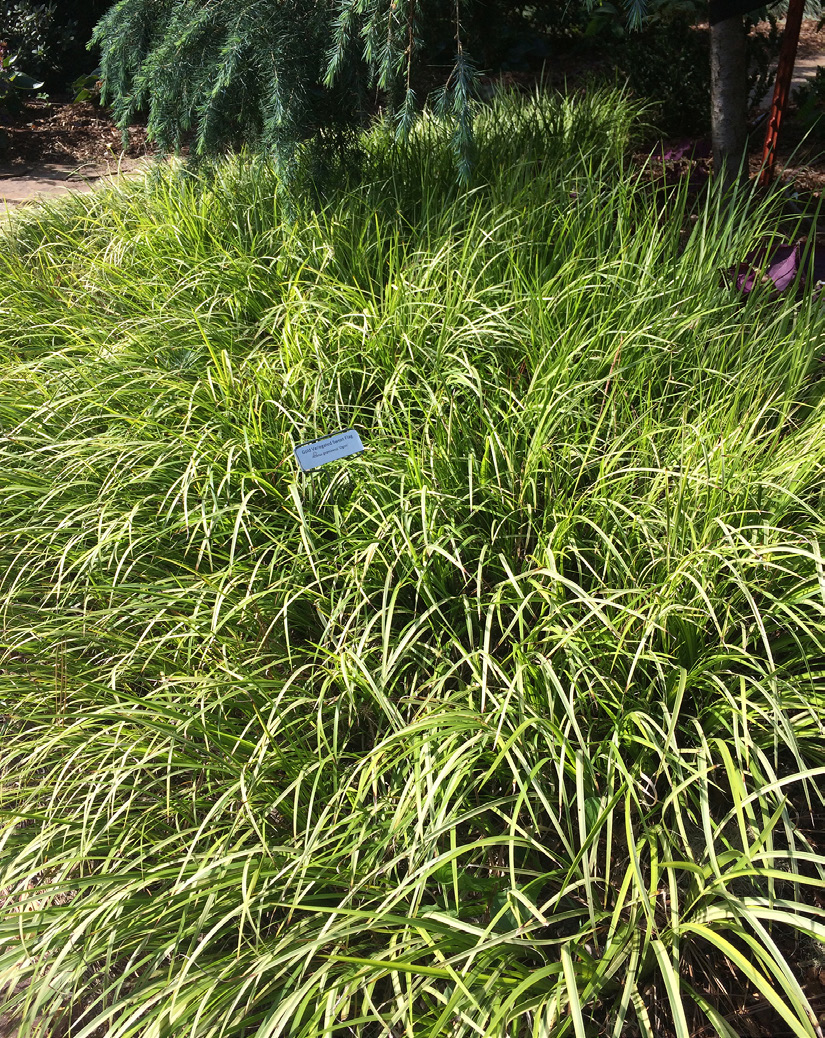
Acorus gramineus is commonly called grassy-leaved sweet flag. It is native to wetland areas of China, Japan, Korea, India, Thailand, Myanmar and the Philippines. 'Ogon' is a dwarf plant that features iris-like tufts of narrow, grass-like, variegated leaf blades (6 to 12 inches tall and 1/4 inch wide), which are striped with yellow and green but primarily appear as yellow. Sweet flag is easily grown in average, medium to wet soils in full sun to part shade and performs well in both boggy conditions and consistently moist garden soils. Never allow soils to dry out. Plants appreciate some relief from hot summer sun (e.g., afternoon shade or filtered sun) when grown in hot summer climates. Foliage is sweetly fragrant when bruised (hence the common name of sweet flag).
Exposure: Full sun, part shade
Soil: Medium to wet
Hardiness: USDA Zones 5 to 9
Hellebore
Helleborus
Hellebores, also known as lenten rose, belong to a genus of mostly evergreen 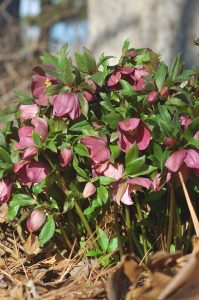 herbaceous plants that are prized for their ability to flower in late winter. The
flower stalks rise out of the leaf litter or through the snow to display nodding flowers
that range in color from green to white, yellow or even purple with some cultivars
producing spotted flowers. Recently, hybrids have been selected for outward-facing
flowers and brighter colors, increasing their garden value. Hellebores are tough plants
requiring little special care other than shade and pruning of old foliage. They are
excellent for the woodland garden as understory plants, where they will be protected
by shade.
herbaceous plants that are prized for their ability to flower in late winter. The
flower stalks rise out of the leaf litter or through the snow to display nodding flowers
that range in color from green to white, yellow or even purple with some cultivars
producing spotted flowers. Recently, hybrids have been selected for outward-facing
flowers and brighter colors, increasing their garden value. Hellebores are tough plants
requiring little special care other than shade and pruning of old foliage. They are
excellent for the woodland garden as understory plants, where they will be protected
by shade.
Exposure: Shade
Soil: Moist, well drained
Hardiness: USDA Zone 6
Indian Pink
Spigelia marilandica
Indian pink, also called pinkroot and woodland pinkroot, is a native species to the
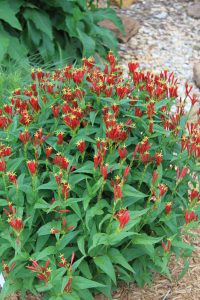 southeastern U.S. It is an excellent plant for shady gardens. Indian pink is an upright,
multi-stemmed clump-forming perennial that is 1 to 2 feet tall and 1 ½ feet wide with
bright, glossy green leaves. Numerous flowers appear in late spring/early summer and
are tubular, deep red with a contrasting yellow throat that flares at the tip to form
five-pointed lobes (a yellow star). Indian pink grows in part shade to full shade
in moist soils, but does really well in full sun and is quite drought tolerant once
established. Use Indian pink in a woodland garden, perennial border, rain garden or
native garden. Hummingbirds and butterflies are attracted to the beautiful, tubular
flowers.
southeastern U.S. It is an excellent plant for shady gardens. Indian pink is an upright,
multi-stemmed clump-forming perennial that is 1 to 2 feet tall and 1 ½ feet wide with
bright, glossy green leaves. Numerous flowers appear in late spring/early summer and
are tubular, deep red with a contrasting yellow throat that flares at the tip to form
five-pointed lobes (a yellow star). Indian pink grows in part shade to full shade
in moist soils, but does really well in full sun and is quite drought tolerant once
established. Use Indian pink in a woodland garden, perennial border, rain garden or
native garden. Hummingbirds and butterflies are attracted to the beautiful, tubular
flowers.
Exposure: Full sun to part shade
Soil: Dry to moist
Hardiness: USDA Zones 5 to 9
| Icon | Icon Description |
|---|---|
 |
Native: Plant indigenous to the continental U.S. or a cultivar or hybrid derived from native plants. |
 |
Wildscape: Plant possesses one or more characteristics ideal for habitation by birds, butterflies or other animals. |
 |
Drought Resistant: After initial establishment period (up to two years), plant can withstand short-term drought. |
Japanese Painted Fern
Athyrium nipponicum
Japanese painted fern is a deciduous perennial growing to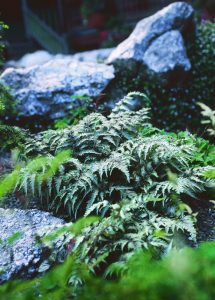 12 inches tall. It can be used in shaded perennial gardens or massed as a ground
cover. Cultivars are available, each with its own pattern of red and silver variegation.
12 inches tall. It can be used in shaded perennial gardens or massed as a ground
cover. Cultivars are available, each with its own pattern of red and silver variegation.
Exposure: Part to full shade
Soil: Moist, well drained
Hardiness: USDA Zone 4
Mexican Feather Grass
Nassella tenuissima
Mexican feather grass is a fine-textured clumping perennial that waves it silvery
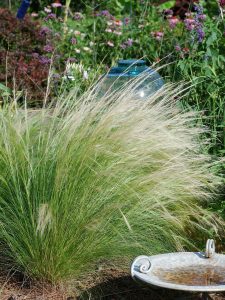 flowers in the slightest breeze. It is drought tolerant and tough despite its refined
appearance. It forms a clump almost 2 feet tall and 3 feet wide as the leaves arch
to the sides. It tolerates a wide variety of conditions, but prefers well-drained
soils. It does not like to be cut to the ground in spring like other grasses. Remove
only the top third of the plant to rejuvenate. It is native to prairies in Texas,
New Mexico and south to central Mexico. It may reseed in the garden.
flowers in the slightest breeze. It is drought tolerant and tough despite its refined
appearance. It forms a clump almost 2 feet tall and 3 feet wide as the leaves arch
to the sides. It tolerates a wide variety of conditions, but prefers well-drained
soils. It does not like to be cut to the ground in spring like other grasses. Remove
only the top third of the plant to rejuvenate. It is native to prairies in Texas,
New Mexico and south to central Mexico. It may reseed in the garden.
Exposure: Full sun to part shade
Soil: Well drained
Hardiness: USDA Zone 7
| Icon | Icon Description |
|---|---|
 |
Native: Plant indigenous to the continental U.S. or a cultivar or hybrid derived from native plants. |
 |
Drought Resistant: After initial establishment period (up to two years), plant can withstand short-term drought. |
Milkweed
Asclepias species
Asclepias species are the milkweeds. Many are native to America and are well adapted
to many soil types. Best known as the host plant for monarch butterflies, milkweeds
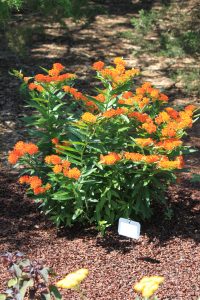 have gained a lot of attention lately. Efforts across the country to reestablish lost
habitat to help save the declining monarch population is taking the front stage for
gardeners, butterfly enthusiasts and conservationists. Butterfly milkweed, Asclepias
tuberosa, is the most popular with bright orange to yellow-orange flowers on upright
stems growing 1 to 3 feet tall. Butterfly milkweed was named the 2017 Perennial of
the Year by the Perennial Plant Association. Milkweeds in general grow in average,
dry to medium, well-drained soils in full sun, are very drought tolerant and have
no serious pest problems. Grow in native plant gardens, wild gardens, meadows, naturalized
areas, perennial borders and cottage style gardens.
have gained a lot of attention lately. Efforts across the country to reestablish lost
habitat to help save the declining monarch population is taking the front stage for
gardeners, butterfly enthusiasts and conservationists. Butterfly milkweed, Asclepias
tuberosa, is the most popular with bright orange to yellow-orange flowers on upright
stems growing 1 to 3 feet tall. Butterfly milkweed was named the 2017 Perennial of
the Year by the Perennial Plant Association. Milkweeds in general grow in average,
dry to medium, well-drained soils in full sun, are very drought tolerant and have
no serious pest problems. Grow in native plant gardens, wild gardens, meadows, naturalized
areas, perennial borders and cottage style gardens.
Exposure: Full sun to part shade
Soil: Tolerant of most soils
Hardiness: USDA Zones 4 to 10
| Icon | Icon Description |
|---|---|
 |
Native: Plant indigenous to the continental U.S. or a cultivar or hybrid derived from native plants. |
 |
Wildscape: Plant possesses one or more characteristics ideal for habitation by birds, butterflies or other animals. |
 |
Drought Resistant: After initial establishment period (up to two years), plant can withstand short-term drought. |
Mugwort
Artemisia ‘Powis Castle’
With dense mounds of lacy silver foliage, this 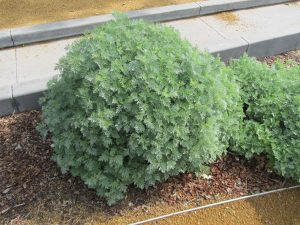 perennial reaches a height of 3 feet tall and remains evergreen during mild winters.
It is prized for its feathery foliage and drought tolerance.
perennial reaches a height of 3 feet tall and remains evergreen during mild winters.
It is prized for its feathery foliage and drought tolerance.
Exposure: Full sun to part shade
Soil: Well drained
Hardiness: USDA Zone 5
| Icon | Icon Description |
|---|---|
 |
Drought Resistant: After initial establishment period (up to two years), plant can withstand short-term drought. |
Narrow-Leaf Ironweed
Vernonia lettermannii
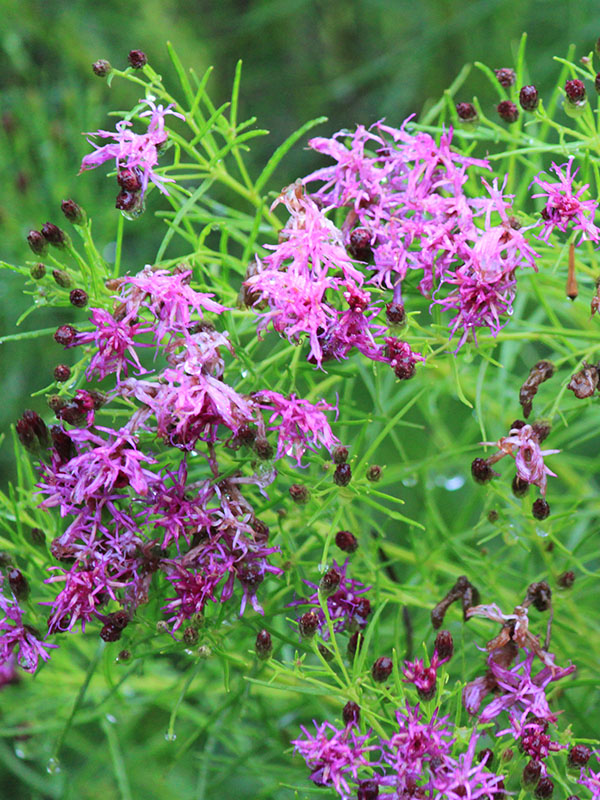 Narrow-leaf or Letterman’s ironweed is an upright, clump-forming, herbaceous perennial
native to rocky outcrops, floodplains and river scours in west-central Arkansas and
adjacent areas of Oklahoma. Plants can reach around 2 foot tall with an equal spread.
The finely textured leaves are thin and narrow. Flat-topped inflorescences of bright
purple flowers appear in mid to late summer. Highly attractive to hummingbirds, butterflies
and other pollinators. Easily grown in medium to dry, well-draining soils of average
fertility in full sun. Tolerant of various soil conditions, including hot, dry, rocky
and alkaline. Also tolerant of occasional flooding and drought once established. A
rugged perennial for fine texture in pollinator gardens, native plantings, slopes,
rock gardens and xeriscapes. ‘Iron Butterfly’ is a vigorous cultivar selected for
its compact, densely mounding habit and showy, long-lasting display of purple blooms.
Narrow-leaf or Letterman’s ironweed is an upright, clump-forming, herbaceous perennial
native to rocky outcrops, floodplains and river scours in west-central Arkansas and
adjacent areas of Oklahoma. Plants can reach around 2 foot tall with an equal spread.
The finely textured leaves are thin and narrow. Flat-topped inflorescences of bright
purple flowers appear in mid to late summer. Highly attractive to hummingbirds, butterflies
and other pollinators. Easily grown in medium to dry, well-draining soils of average
fertility in full sun. Tolerant of various soil conditions, including hot, dry, rocky
and alkaline. Also tolerant of occasional flooding and drought once established. A
rugged perennial for fine texture in pollinator gardens, native plantings, slopes,
rock gardens and xeriscapes. ‘Iron Butterfly’ is a vigorous cultivar selected for
its compact, densely mounding habit and showy, long-lasting display of purple blooms.
Exposure: Sun
Soil: Dry to medium moisture; tolerates drought, erosion, dry, shallow-rocky
Hardiness: USDA Zones 4 to 9
| Icon | Icon Description |
|---|---|
 |
Native: Plant indigenous to the continental U.S. or a cultivar or hybrid derived from native plants. |
 |
Wildscape: Plant possesses one or more characteristics ideal for habitation by birds, butterflies or other animals. |
 |
Drought Resistant: After initial establishment period (up to two years), plant can withstand short-term drought. |
Perennial Plumbago
Ceratostigma plumbaginoides
Perennial plumbago, also known as leadwort, is a neat, well-behaved plant that grows
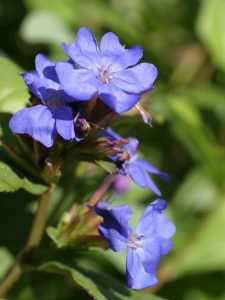 8 to 12 inches high and spreads to 18 inches, making it welcome at the front of a
mixed border or massed as a ground cover. Its cold hardiness is much better than true
plumbago. The terminal clusters of blue flowers appear from summer through fall when
the foliage turns a bronze-red before going dormant for the winter. It is best to
use perennial plumbago in a well drained soil and to cut old stems to the ground each
spring for vigorous regrowth.
8 to 12 inches high and spreads to 18 inches, making it welcome at the front of a
mixed border or massed as a ground cover. Its cold hardiness is much better than true
plumbago. The terminal clusters of blue flowers appear from summer through fall when
the foliage turns a bronze-red before going dormant for the winter. It is best to
use perennial plumbago in a well drained soil and to cut old stems to the ground each
spring for vigorous regrowth.
Exposure: Full sun to part shade
Soil: Well drained
Hardiness: USDA Zone 5
Phlox, Volcano® series
Phlox paniculata
Phlox Volcano® is more compact, fragrant and powdery mildew tolerant than other garden phlox types.
Plants develop sturdy stems 24 to 28 inches tall, with deep green 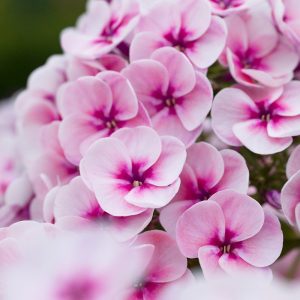 leaves and an abundance of large flowers that appear from June to September if plants
are cut back after initial bloom. Flower colors range from red, pink, ruby, white,
lavender and purple; flowers may also have eyes of pink, red or white. They can be
bicolored such as with ‘Lilac Splash.’ It does not mind most soils, but needs well-drained
soil; irrigate with soaker or drip irrigation to keep foliage dry. Full sun is the
best exposure for Volcano® phlox, but it will grow in part shade. Too much shade and poor air circulation increases
chances of mildew developing, though it does not seem to inhibit flowering. Once established,
phlox is very adaptable. It is grown as an accent, in groups or masses. It also works
well in native plant gardens, wild gardens, meadows, naturalized areas, perennial
borders and cottage style gardens. Butterflies and hummingbirds are attracted to the
colorful, fragrant flowers.
leaves and an abundance of large flowers that appear from June to September if plants
are cut back after initial bloom. Flower colors range from red, pink, ruby, white,
lavender and purple; flowers may also have eyes of pink, red or white. They can be
bicolored such as with ‘Lilac Splash.’ It does not mind most soils, but needs well-drained
soil; irrigate with soaker or drip irrigation to keep foliage dry. Full sun is the
best exposure for Volcano® phlox, but it will grow in part shade. Too much shade and poor air circulation increases
chances of mildew developing, though it does not seem to inhibit flowering. Once established,
phlox is very adaptable. It is grown as an accent, in groups or masses. It also works
well in native plant gardens, wild gardens, meadows, naturalized areas, perennial
borders and cottage style gardens. Butterflies and hummingbirds are attracted to the
colorful, fragrant flowers.
Exposure: Full sun to part shade
Soil: Tolerant of most soils
Hardiness: USDA Zones 4 to 10
| Icon | Icon Description |
|---|---|
 |
Native: Plant indigenous to the continental U.S. or a cultivar or hybrid derived from native plants. |
 |
Wildscape: Plant possesses one or more characteristics ideal for habitation by birds, butterflies or other animals. |
Prinz Heinrish Japanese Anemone
Anemone hupehensis var. japonica ‘Prinz Heinrich’ 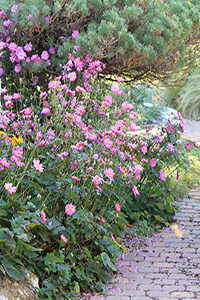
Prinz Heinrich Japanese anemone is an excellent perennial for late summer to early fall color that grows best in a part shade location or spot protected from the late afternoon sun and winds; in full sun and dry conditions, the foliage will often burn. It prefers fertile, consistently moist soil that is neutral to slightly alkaline with good drainage; avoid wet soils, particularly in winter. In too much shade the flower stems tend to flop. Flowers are semi-double, rose-pink, with narrow overlapping tepals surrounding a central cluster of golden-yellow stamens. Flowers are produced on long, upright, wiry but graceful branching flower stems that arise above the basal foliage. The plant grows to about 28 inches high and spreads by rhizomes.
Exposure: Full sun to part shade
Soil: Moist, well drained
Hardiness: USDA Zones 5 to 8
| Icon | Icon Description |
|---|---|
 |
Wildscape: Plant possesses one or more characteristics ideal for habitation by birds, butterflies or other animals. |
Purple Coneflower
Echinacea purpurea ‘Magnus’
‘Magnus’ purple coneflower is known for its rose-colored 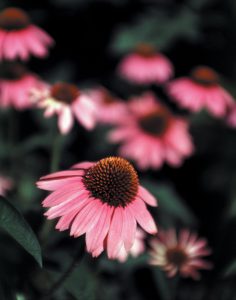 flowers that appear in early summer and sporadically until frost. ‘Magnus’ is a clump-forming
perennial that grows 2 to 3 feet tall. Use this heat- and drought-tolerant perennial
in a native plant garden, perennial border or as a cut flower.
flowers that appear in early summer and sporadically until frost. ‘Magnus’ is a clump-forming
perennial that grows 2 to 3 feet tall. Use this heat- and drought-tolerant perennial
in a native plant garden, perennial border or as a cut flower.
Exposure: Full sun to part shade
Soil: Well drained
Hardiness: USDA Zone 3
| Icon | Icon Description |
|---|---|
 |
Native: Plant indigenous to the continental U.S. or a cultivar or hybrid derived from native plants. |
 |
Wildscape: Plant possesses one or more characteristics ideal for habitation by birds, butterflies or other animals. |
Rattlesnake Master
Eryngium yuccifolium
Rattlesnake master is a native species to the tallgrass prairies. Leaves of rattlesnake
master are parallel-veined, bristly-edged, sword-shaped, medium green leaves (up to
3 feet long) and resemble those of yucca. Flowers are greenish-white and tightly packed
 into globular, 1-inch diameter heads resembling thistles. The flowering heads attract
many kinds of insects. Seed heads persist and provide winter interest. Rattlesnake
master prefers dryish, sandy soils, but tolerates clay and shallow-rocky soils. Plants
tend to open up and flop in overly fertile soils or in anything less than full sun.
This is a taprooted plant which transplants poorly and is best left undisturbed once
established. Use rattlesnake master in a xeriscape garden, perennial border or native
garden. Group plants in naturalized areas for best affect.
into globular, 1-inch diameter heads resembling thistles. The flowering heads attract
many kinds of insects. Seed heads persist and provide winter interest. Rattlesnake
master prefers dryish, sandy soils, but tolerates clay and shallow-rocky soils. Plants
tend to open up and flop in overly fertile soils or in anything less than full sun.
This is a taprooted plant which transplants poorly and is best left undisturbed once
established. Use rattlesnake master in a xeriscape garden, perennial border or native
garden. Group plants in naturalized areas for best affect.
Exposure: Full sun
Soil: Dry to moist, well drained
Hardiness: USDA Zones 3 to 8
| Icon | Icon Description |
|---|---|
 |
Native: Plant indigenous to the continental U.S. or a cultivar or hybrid derived from native plants. |
 |
Wildscape: Plant possesses one or more characteristics ideal for habitation by birds, butterflies or other animals. |
 |
Drought Resistant: After initial establishment period (up to two years), plant can withstand short-term drought. |
Sedges
Carex species
Sedges belong to the genus Carex, which is a genus of many species, most from wet
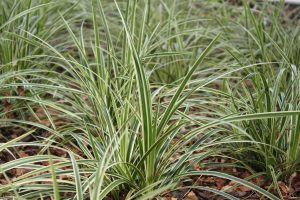 areas such as bogs. Sedges have triangular, grass-like stems and panicles of short
flower spikes. Native and Asian selections are available, providing a wide range of
characteristics. Foliage can be evergreen or deciduous and colors range from green,
brown/rust, golden, blue to variegated. Sedges are grown in groups or masses, as a
lawn substitute, in naturalized areas, perennial borders and habitat restoration.
They are grown particularly in shady areas where the variegated varieties really shine.
Some require damp or wet conditions, while others are relatively drought tolerant.
areas such as bogs. Sedges have triangular, grass-like stems and panicles of short
flower spikes. Native and Asian selections are available, providing a wide range of
characteristics. Foliage can be evergreen or deciduous and colors range from green,
brown/rust, golden, blue to variegated. Sedges are grown in groups or masses, as a
lawn substitute, in naturalized areas, perennial borders and habitat restoration.
They are grown particularly in shady areas where the variegated varieties really shine.
Some require damp or wet conditions, while others are relatively drought tolerant.
Exposure: Full sun to full shade
Soil: Dry to wet
Hardiness: USDA Zones 3 to 10
| Icon | Icon Description |
|---|---|
 |
Native: Plant indigenous to the continental U.S. or a cultivar or hybrid derived from native plants. |
 |
Wildscape: Plant possesses one or more characteristics ideal for habitation by birds, butterflies or other animals. |
 |
Drought Resistant: After initial establishment period (up to two years), plant can withstand short-term drought. |
Switchgrass
Panicum virgatum
Switchgrass is native throughout North America and is a dominant species of the tallgrass
prairies. It does not mind most soils and actually grows well in wet and dry locations.
Full sun is the best exposure for switchgrass, but it will grow in part shade; 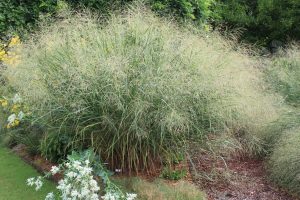 too much shade or rich soils may result in floppy plants. Switchgrass is a warm-season
perennial, growing largely as a bunchgrass 3 to 6 feet tall, but may spread by rhizomes
or self-seeding. Switchgrass has an upright, stiff form overall. Flower panicles are
open, lacy sprays, with a purplish tint that persists into the winter. Leaf color
is generally medium green, turning yellow, sometimes with orange tints in fall; however,
several cultivars exist – ‘Heavy Metal’ has metallic-blue foliage, ‘Northwind’ is
bluish-green, ‘Shenandoah’ has foliage with dark purple tips and ‘Cheyenne Sky’ turns
wine red. Winter color is tan to beige. Once established, switchgrass is very drought
tolerant. It is grown as an accent, in groups or masses and can be effective as a
screen. It also works well in native plant gardens, wild gardens, meadows, naturalized
areas, as well as rain, water and bog gardens.
too much shade or rich soils may result in floppy plants. Switchgrass is a warm-season
perennial, growing largely as a bunchgrass 3 to 6 feet tall, but may spread by rhizomes
or self-seeding. Switchgrass has an upright, stiff form overall. Flower panicles are
open, lacy sprays, with a purplish tint that persists into the winter. Leaf color
is generally medium green, turning yellow, sometimes with orange tints in fall; however,
several cultivars exist – ‘Heavy Metal’ has metallic-blue foliage, ‘Northwind’ is
bluish-green, ‘Shenandoah’ has foliage with dark purple tips and ‘Cheyenne Sky’ turns
wine red. Winter color is tan to beige. Once established, switchgrass is very drought
tolerant. It is grown as an accent, in groups or masses and can be effective as a
screen. It also works well in native plant gardens, wild gardens, meadows, naturalized
areas, as well as rain, water and bog gardens.
Exposure: Sun, part shade
Soil: Tolerant of most soils
Hardiness: USDA Zones 5 to 9
| Icon | Icon Description |
|---|---|
 |
Native: Plant indigenous to the continental U.S. or a cultivar or hybrid derived from native plants. |
 |
Wildscape: Plant possesses one or more characteristics ideal for habitation by birds, butterflies or other animals. |
 |
Drought Resistant: After initial establishment period (up to two years), plant can withstand short-term drought. |
Toad Lily
Tricyrtis hirta
Toad lilies are known for their very unique flowers. Flowers are pale lilac with dark
purple spots that appear on upright arching stems in late summer to early fall, when
many 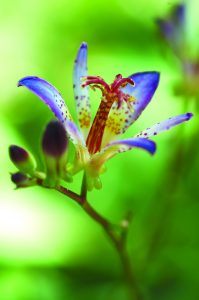 other plants are beginning to wind down. The flowers are small, so place toad lily
in a spot where they can be appreciated up close. The plant grows 2 to 3 feet high
and about 2 feet wide, with bright green leaves. They are excellent for the woodland
garden where they will be protected by shade. Toad lily is easy to grow, resistant
to deer, somewhat drought tolerant, but grows best in moist soils, even tolerating
wet conditions. Several cultivars with varying flower colors are available.
other plants are beginning to wind down. The flowers are small, so place toad lily
in a spot where they can be appreciated up close. The plant grows 2 to 3 feet high
and about 2 feet wide, with bright green leaves. They are excellent for the woodland
garden where they will be protected by shade. Toad lily is easy to grow, resistant
to deer, somewhat drought tolerant, but grows best in moist soils, even tolerating
wet conditions. Several cultivars with varying flower colors are available.
Exposure: Part to full shade
Soil: Moist, well drained
Hardiness: USDA Zones 4 to 8
Turk's Cap
Malvaviscus arboreus var. drummondii
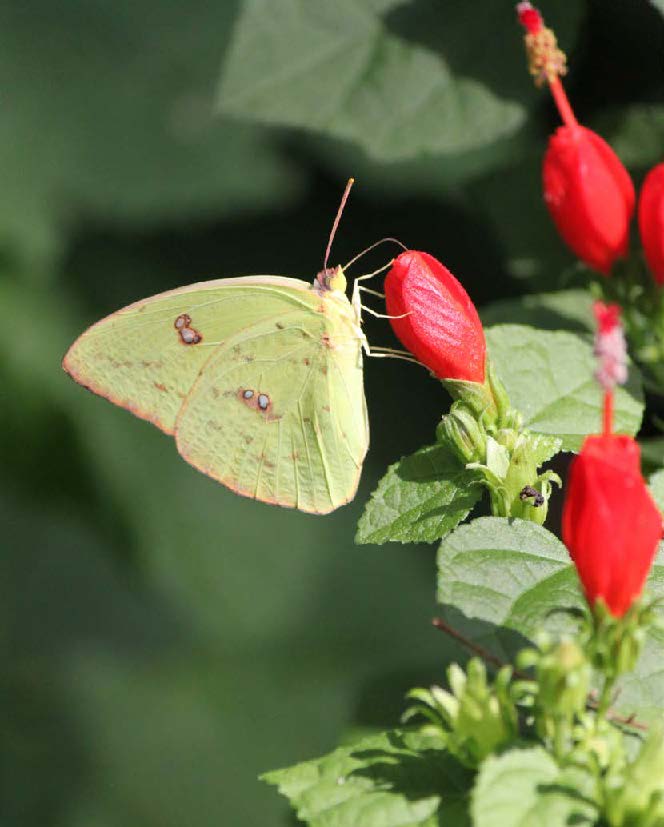 This native perennial grows 2-3’ high (sometimes higher) and 3-5’ wide. The species
has bright-red, pendant, hibiscus-like flowers that never fully open with petals overlapping
to form a loose tube said to
This native perennial grows 2-3’ high (sometimes higher) and 3-5’ wide. The species
has bright-red, pendant, hibiscus-like flowers that never fully open with petals overlapping
to form a loose tube said to
resemble a Turkish turban, hence its common name, Turk’s Cap. Red flowers usually
are produced in showy profusion during hot weather at the end of summer and early
fall. White- and pink-flowered cultivars and a variegated form are available. Turk’s
Cap is a good ornamental for shady sites.
Exposure: Sun to part shade
Soil: Moist, well drained
Hardiness: USDA Zone 7-10
| Icon | Icon Description |
|---|---|
 |
Native: Plant indigenous to the continental U.S. or a cultivar or hybrid derived from native plants. |
 |
Wildscape: Plant possesses one or more characteristics ideal for habitation by birds, butterflies or other animals. |
 |
Drought Resistant: After initial establishment period (up to two years), plant can withstand short-term drought. |
Verbena
Verbena canadensis ‘Homestead Purple’
‘Homestead Purple’s’ deep purple flowers and trailing habit  make it perfect for hanging baskets, as a ground cover or as the foreground of a mixed
border. This North American native will bloom from spring to frost, slowing down only
slightly during the hottest months.
make it perfect for hanging baskets, as a ground cover or as the foreground of a mixed
border. This North American native will bloom from spring to frost, slowing down only
slightly during the hottest months.
Exposure: Full sun
Soil: Moist, well drained
Hardiness: USDA Zone 4
| Icon | Icon Description |
|---|---|
 |
Native: Plant indigenous to the continental U.S. or a cultivar or hybrid derived from native plants. |
 |
Wildscape: Plant possesses one or more characteristics ideal for habitation by birds, butterflies or other animals. |
 |
Drought Resistant: After initial establishment period (up to two years), plant can withstand short-term drought. |
Shrubs
American Beautyberry
Callicarpa americana
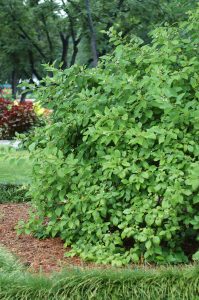
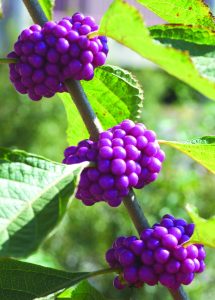 American beautyberry is a native deciduous shrub that produces inconspicuous lavender
flowers in mid summer. As fall approaches, the plant becomes laden with brightly colored
clusters of purple fruit, producing a striking display. American beautyberry prefers
light shade or protection from the afternoon sun in Oklahoma. It grows from 5 to 10
feet high and just as broad. Overgrown plants can be rejuvenated by cutting them to
the ground in winter without sacrificing fruit, since the flowers are produced on
new growth. This native shrub can be massed as an informal hedge, incorporated into
a mixed border or used as an understory plant in a naturalistic garden setting. White-fruited
cultivars are also available.
American beautyberry is a native deciduous shrub that produces inconspicuous lavender
flowers in mid summer. As fall approaches, the plant becomes laden with brightly colored
clusters of purple fruit, producing a striking display. American beautyberry prefers
light shade or protection from the afternoon sun in Oklahoma. It grows from 5 to 10
feet high and just as broad. Overgrown plants can be rejuvenated by cutting them to
the ground in winter without sacrificing fruit, since the flowers are produced on
new growth. This native shrub can be massed as an informal hedge, incorporated into
a mixed border or used as an understory plant in a naturalistic garden setting. White-fruited
cultivars are also available.
Exposure: Part shade
Soil: Moist, well drained
Hardiness: USDA Zone 6
| Icon | Icon Description |
|---|---|
 |
Native: Plant indigenous to the continental U.S. or a cultivar or hybrid derived from native plants. |
 |
Wildscape: Plant possesses one or more characteristics ideal for habitation by birds, butterflies or other animals. |
Barberry, Columnar Forms
Berberis thunbergii
Barberries are, in general, pretty tough and offer a wide variety of leaf color. The
newest forms are the columnar types of shrubs offering a vertical element in the 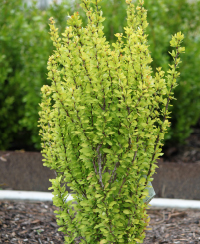 landscape. These forms of barberry include the Rocket and Pillar collections. Each
offers upright, narrow plants in different foliage colors of golden to red and orange,
growing 3 to 5 feet high and not more than 2 feet wide. Barberries prefer moist, well-drained
soils, but are adaptable to a wide range of soils and, once established, can be quite
drought tolerant. Barberries have no serious pest problems and require very little
maintenance, making them excellent for the urban landscape. Grow columnar forms of
barberry as a specimen, in groupings, in shrub borders and as a foundation planting.
landscape. These forms of barberry include the Rocket and Pillar collections. Each
offers upright, narrow plants in different foliage colors of golden to red and orange,
growing 3 to 5 feet high and not more than 2 feet wide. Barberries prefer moist, well-drained
soils, but are adaptable to a wide range of soils and, once established, can be quite
drought tolerant. Barberries have no serious pest problems and require very little
maintenance, making them excellent for the urban landscape. Grow columnar forms of
barberry as a specimen, in groupings, in shrub borders and as a foundation planting.
Exposure: Full sun to part shade
Soil: Moist, well drained
Hardiness: USDA Zones 3 to 8
| Icon | Icon Description |
|---|---|
 |
Drought Resistant: After initial establishment period (up to two years), plant can withstand short-term drought. |
Blue Muffin® Viburnum
Viburnum dentatum ‘Christom’
Blue Muffin® viburnum is a small, compact version of the native arrowwood viburnum 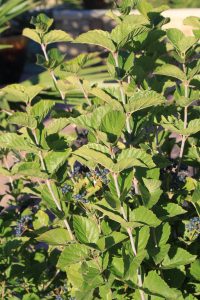 that grows about 3 to 5 feet high and just as wide. Blue Muffin® prefers moist, well-drained soils, but is adaptable to a wide range of other soils.
Established plants are somewhat drought tolerant, have no serious pest problems and
require very little maintenance, making them excellent for the urban landscape. As
with many viburnums, Blue Muffin® offers season-long interest with white spring flowers, dark green summer foliage
that turns red and orange in fall and blue fruits the birds love in late summer/fall.
Prune right after flowering, but only if necessary. Grow Blue Muffin® as a specimen, in groupings, in shrub borders, as a foundation planting or as a hedge.
that grows about 3 to 5 feet high and just as wide. Blue Muffin® prefers moist, well-drained soils, but is adaptable to a wide range of other soils.
Established plants are somewhat drought tolerant, have no serious pest problems and
require very little maintenance, making them excellent for the urban landscape. As
with many viburnums, Blue Muffin® offers season-long interest with white spring flowers, dark green summer foliage
that turns red and orange in fall and blue fruits the birds love in late summer/fall.
Prune right after flowering, but only if necessary. Grow Blue Muffin® as a specimen, in groupings, in shrub borders, as a foundation planting or as a hedge.
Exposure: Full sun to part shade
Soil: Moist, well drained
Hardiness: USDA Zones 3 to 8
| Icon | Icon Description |
|---|---|
 |
Native: Plant indigenous to the continental U.S. or a cultivar or hybrid derived from native plants. |
 |
Wildscape: Plant possesses one or more characteristics ideal for habitation by birds, butterflies or other animals. |
 |
Drought Resistant: After initial establishment period (up to two years), plant can withstand short-term drought. |
Bush Clover
Lespedeza thunbergii subsp. thunbergii ‘Little Volcano’ and ‘Gibraltar’
Bush clovers are hardy, semi-woody deciduous shrubs reaching 4 to 6 feet high and
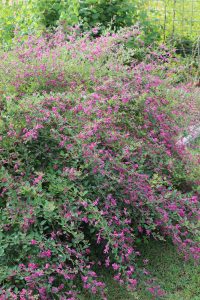 at least as wide with arching stems. In harsh winters, it can die to the ground, but
quickly comes back the following spring. Late winter or early spring pruning may be
necessary to rejuvenate the plant. Flowers develop on new wood and are rosy-purple
in late summer to early fall, completely covering the plant. Bush clovers perform
well in sandy, infertile soil and are very drought tolerant once established; ideal
drainage is essential. ‘Little Volcano,’ a selection from Japan, is more upright with
dark green foliage and red-purple flowers. Foliage turns golden after bloom in the
fall. ‘Gibraltar’ is a spectacular selection with long, arching stems also covered
in rosy-purple flowers from late summer to early fall.
at least as wide with arching stems. In harsh winters, it can die to the ground, but
quickly comes back the following spring. Late winter or early spring pruning may be
necessary to rejuvenate the plant. Flowers develop on new wood and are rosy-purple
in late summer to early fall, completely covering the plant. Bush clovers perform
well in sandy, infertile soil and are very drought tolerant once established; ideal
drainage is essential. ‘Little Volcano,’ a selection from Japan, is more upright with
dark green foliage and red-purple flowers. Foliage turns golden after bloom in the
fall. ‘Gibraltar’ is a spectacular selection with long, arching stems also covered
in rosy-purple flowers from late summer to early fall.
Exposure: Full sun to part shade
Soil: Tolerates poor, infertile soil; excellent drainage is essential
Hardiness: USDA Zones 6 to 10
| Icon | Icon Description |
|---|---|
 |
Wildscape: Plant possesses one or more characteristics ideal for habitation by birds, butterflies or other animals. |
 |
Drought Resistant: After initial establishment period (up to two years), plant can withstand short-term drought. |
Buttonbush
Cephalanthus occidentalis 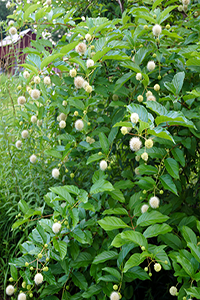
Buttonbush is a native shrub found growing throughout most of Oklahoma bordering streams and lakes, except in the panhandle. It is a medium to large shrub with a course, open-rounded habit from 5 to 12 feet tall and 4 to 8 feet wide. Leaves are dark, glossy green and lack significant fall color. Clusters of white, fragrant flowers bloom June to July and look like a pincushion. Flowers are very attractive to hummingbirds, bees, butterflies, and other pollinators and is considered a good honey plant. Ducks and other water birds consume the seed. The round, ball-like fruit structure persists on the plant and may be reddish brown.
Exposure: Full sun to part shade
Soil: Moist, wet; wide variety except dry
Hardiness: USDA Zones 4 to 9
| Icon | Icon Description |
|---|---|
 |
Native: Plant indigenous to the continental U.S. or a cultivar or hybrid derived from native plants. |
 |
Wildscape: Plant possesses one or more characteristics ideal for habitation by birds, butterflies or other animals. |
Chaste Tree
Vitex species
Vitex is a multi-stemmed large shrub, but can be trained into a small tree. Leaves
are palmately compound and dark green. Flowers appear in early summer and continue
to bloom sporadically through summer and fall. Flowers of Vitex can be blue, lavender,
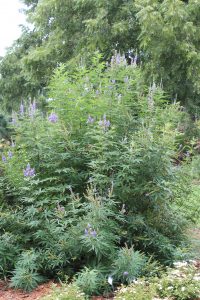 pink or white. Old strains had small spikes of flowers; improved varieties have large
spikes (8 to 12 inches long) of colorful flowers that are fragrant and make excellent
cut flowers. Vitex is not too picky of soils and is easy to grow, very heat, drought
and pest tolerant and an excellent choice for a xeric garden. Vitex is often considered
an excellent replacement for lilacs, which grow much better in colder climates, and
it attracts butterflies and hummingbirds.
pink or white. Old strains had small spikes of flowers; improved varieties have large
spikes (8 to 12 inches long) of colorful flowers that are fragrant and make excellent
cut flowers. Vitex is not too picky of soils and is easy to grow, very heat, drought
and pest tolerant and an excellent choice for a xeric garden. Vitex is often considered
an excellent replacement for lilacs, which grow much better in colder climates, and
it attracts butterflies and hummingbirds.
Exposure: Full sun to part shade
Soil: Moist, well drained
Hardiness: USDA Zones 4 to 9
| Icon | Icon Description |
|---|---|
 |
Wildscape: Plant possesses one or more characteristics ideal for habitation by birds, butterflies or other animals. |
 |
Drought Resistant: After initial establishment period (up to two years), plant can withstand short-term drought. |
Chokeberry
Aronia
There are two species in the genus Aronia, red chokeberry (Aronia arbutifolia) and
black chokeberry (Aronia melanocarpa), both are excellent landscape plants. As their
common 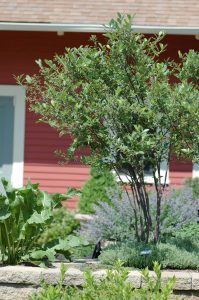 names suggest, fruit color is the major difference between the two. They both produce
clusters of white flowers in spring, have excellent red fall foliage, grow to about
10 feet high and thrive in almost any soil type. Black chokeberry is getting a lot
of attention as a “super fruit” for its high levels of antioxidants and can be used
to make juice, jelly or wine. Aronia work well massed in a naturalized setting or
at the back of a border, since the stems are usually bare near the base, leaving room
for garden perennials.
names suggest, fruit color is the major difference between the two. They both produce
clusters of white flowers in spring, have excellent red fall foliage, grow to about
10 feet high and thrive in almost any soil type. Black chokeberry is getting a lot
of attention as a “super fruit” for its high levels of antioxidants and can be used
to make juice, jelly or wine. Aronia work well massed in a naturalized setting or
at the back of a border, since the stems are usually bare near the base, leaving room
for garden perennials.
Exposure: Full sun to part shade
Soil: Tolerant of most soils
Hardiness: USDA Zone 4
| Icon | Icon Description |
|---|---|
 |
Native: Plant indigenous to the continental U.S. or a cultivar or hybrid derived from native plants. |
 |
Wildscape: Plant possesses one or more characteristics ideal for habitation by birds, butterflies or other animals. |
Crossvine
Bignonia capreolata ‘Tangerine Beauty’
A true beauty, especially in the spring when ‘Tangerine Beauty’ is covered in orange,
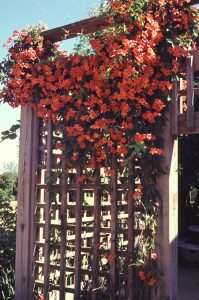 trumpet-shaped flowers. This semi-evergreen vine can climb by twining its branches
around a structure or can use its adhesive tendrils to cling to a wall, easily reaching
heights of 30 feet or more. As temperatures cool in the fall, the leaves have a purple
cast and are evergreen during a mild winter or in a protected spot. Beauty is not
the only reason for using crossvine; it is also a tough plant, tolerant of heat and
drought once established.
trumpet-shaped flowers. This semi-evergreen vine can climb by twining its branches
around a structure or can use its adhesive tendrils to cling to a wall, easily reaching
heights of 30 feet or more. As temperatures cool in the fall, the leaves have a purple
cast and are evergreen during a mild winter or in a protected spot. Beauty is not
the only reason for using crossvine; it is also a tough plant, tolerant of heat and
drought once established.
Exposure: Full sun to part shade
Soil: Tolerant of most soils
Hardiness: USDA Zone 6
| Icon | Icon Description |
|---|---|
 |
Native: Plant indigenous to the continental U.S. or a cultivar or hybrid derived from native plants. |
 |
Wildscape: Plant possesses one or more characteristics ideal for habitation by birds, butterflies or other animals. |
 |
Drought Resistant: After initial establishment period (up to two years), plant can withstand short-term drought. |
Deciduous Holly
Ilex decidua
Deciduous holly is a native plant typically grown as a 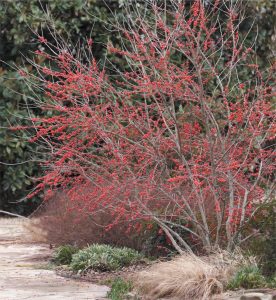 multi-stemmed shrub. It tolerates heat, drought and poorly drained soils and reaches
a height of 8 to 12 feet. Female cultivars of deciduous holly have beautiful red to
yellow berries that remain on the plant through the winter. Male and female cultivars
should be planted to ensure fruit production.
multi-stemmed shrub. It tolerates heat, drought and poorly drained soils and reaches
a height of 8 to 12 feet. Female cultivars of deciduous holly have beautiful red to
yellow berries that remain on the plant through the winter. Male and female cultivars
should be planted to ensure fruit production.
Exposure: Full sun to part shade
Soil: Poorly to well drained
Hardiness: USDA Zone 5
| Icon | Icon Description |
|---|---|
 |
Native: Plant indigenous to the continental U.S. or a cultivar or hybrid derived from native plants. |
 |
Wildscape: Plant possesses one or more characteristics ideal for habitation by birds, butterflies or other animals. |
 |
Drought Resistant: After initial establishment period (up to two years), plant can withstand short-term drought. |
Diabolo® Ninebark
Physocarpus opulifolius ‘Monlo’
Diabolo® is a cultivar of ninebark prized for its deep maroon foliage, which contrasts 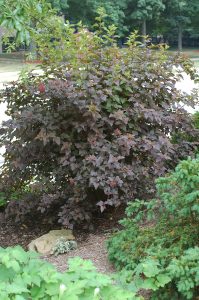 nicely with the clusters of white flowers produced in the spring and is a great companion
for gold or chartreuse-leaved plants. This deciduous shrub grows from 6 to 10 feet
high and just as wide. It can be rejuvenated by pruning it to the ground in winter.
Red fruit extends ninebark’s show into the fall and exfoliating bark adds winter interest.
Diabolo® is a hardy and durable shrub that can be used as a screen, for massing or at the
back of a border.
nicely with the clusters of white flowers produced in the spring and is a great companion
for gold or chartreuse-leaved plants. This deciduous shrub grows from 6 to 10 feet
high and just as wide. It can be rejuvenated by pruning it to the ground in winter.
Red fruit extends ninebark’s show into the fall and exfoliating bark adds winter interest.
Diabolo® is a hardy and durable shrub that can be used as a screen, for massing or at the
back of a border.
Exposure: Full sun to part shade
Soil: Tolerant of most soils
Hardiness: USDA Zone 2
| Icon | Icon Description |
|---|---|
 |
Native: Plant indigenous to the continental U.S. or a cultivar or hybrid derived from native plants. |
 |
Wildscape: Plant possesses one or more characteristics ideal for habitation by birds, butterflies or other animals. |
 |
Drought Resistant: After initial establishment period (up to two years), plant can withstand short-term drought. |
Dwarf Palmetto
Sabal minor
Dwarf palmetto favors the wet alluvial soil in swamps and river bottoms in Texas,
Oklahoma, Arkansas and North Carolina and is the only member of the palm family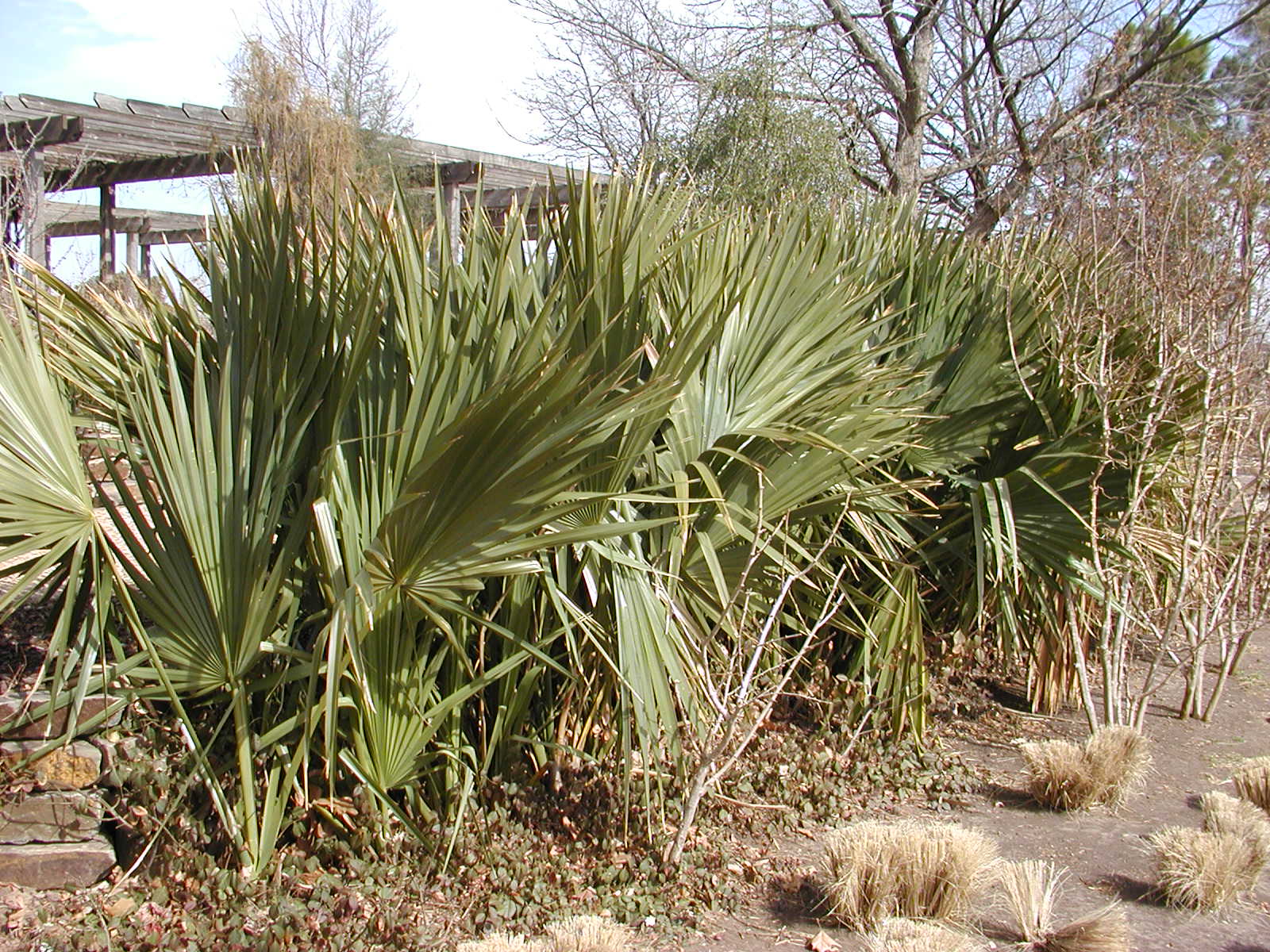 native to Oklahoma. This very slow-growing, ground-hugging rugged fan palm produces
pale green or bluish fan-like, evergreen leaves atop spineless stems arising from
a crown of underground roots and reaches 4 to 6 feet high or more. Flowers are yellowish-white
in late spring followed by edible black, BB-sized fruits that taste like dates. Dwarf
palmetto provides interest and variety to a damp, shaded place. Although this plant
grows native in areas of high to moderate moisture, once established it is fairly
drought tolerant. It is the most cold-tolerant Sabal. In the landscape, it works well
as a specimen plant, in mass plantings or in containers.
native to Oklahoma. This very slow-growing, ground-hugging rugged fan palm produces
pale green or bluish fan-like, evergreen leaves atop spineless stems arising from
a crown of underground roots and reaches 4 to 6 feet high or more. Flowers are yellowish-white
in late spring followed by edible black, BB-sized fruits that taste like dates. Dwarf
palmetto provides interest and variety to a damp, shaded place. Although this plant
grows native in areas of high to moderate moisture, once established it is fairly
drought tolerant. It is the most cold-tolerant Sabal. In the landscape, it works well
as a specimen plant, in mass plantings or in containers.
Exposure: Full sun to part shade (best in part shade)
Soil: Organically rich, moderately fertile, moist
Hardiness: USDA Zones 7 to 10
| Icon | Icon Description |
|---|---|
 |
Native: Plant indigenous to the continental U.S. or a cultivar or hybrid derived from native plants. |
 |
Wildscape: Plant possesses one or more characteristics ideal for habitation by birds, butterflies or other animals. |
 |
Drought Resistant: After initial establishment period (up to two years), plant can withstand short-term drought. |
Flowering Quince, Double Take™ Series
Chaenomeles speciosa
Flowering quince in the Double Take™ series are hardy, deciduous shrubs reaching 4
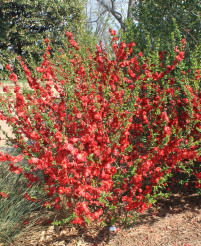 to 5 feet high and at least as wide. Plants in the Double Take™ series produce a profusion
of early spring double flowers that resemble camellias. This is a dense, broad-rounded,
thornless shrub. Bold double flowers (up to 2 inches diameter) bloom before the leaves
fully unfold in an early spring bloom and come in colors of scarlet, orange, pink
and peach. Plants do not produce fruit. Oval to oblong, glossy dark green leaves provide
an attractive look through the summer. Prune lightly after blooms in spring when needed.
Double Take™ flowering quince is very drought tolerant once established.
to 5 feet high and at least as wide. Plants in the Double Take™ series produce a profusion
of early spring double flowers that resemble camellias. This is a dense, broad-rounded,
thornless shrub. Bold double flowers (up to 2 inches diameter) bloom before the leaves
fully unfold in an early spring bloom and come in colors of scarlet, orange, pink
and peach. Plants do not produce fruit. Oval to oblong, glossy dark green leaves provide
an attractive look through the summer. Prune lightly after blooms in spring when needed.
Double Take™ flowering quince is very drought tolerant once established.
Exposure: Full sun to part shade
Soil: Tolerant of most soils, but prefers well drained
Hardiness: USDA Zones 5 to 9
| Icon | Icon Description |
|---|---|
 |
Wildscape: Plant possesses one or more characteristics ideal for habitation by birds, butterflies or other animals. |
 |
Drought Resistant: After initial establishment period (up to two years), plant can withstand short-term drought. |
Glossy Abelia
Abelia x grandiflora
Several new, compact forms of glossy abelia are becoming very popular. ‘Kaleidoscope’
grows 2 to 3 feet high and slightly wider. In spring, leaves appear on bright red
stems 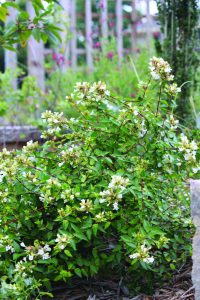 with lime green centers and bright yellow edges, but variegation does not scorch or
burn in hot weather. In fall, color deepens to shades of orange and fiery red. Soft
pink flower buds open to white in late spring. ‘Little Richard’ is a 3-foot by 3-foot
evergreen, with vivid green leaves in summer, taking on a tangerine-pink color in
fall. White flowers bloom from summer to first frost. ‘Rose Creek’ grows 2 to 3 feet
high and 3 to 4 feet wide; it is evergreen with crimson stems. New leaves have a pinkish
cast, maturing to lustrous dark green and turn purple in cold weather. Use abelias
in containers, as formal or informal hedges, accent plants, in mass plantings or in
foundation plantings under windows. Abelias also attract hummingbirds and butterflies
to the garden.
with lime green centers and bright yellow edges, but variegation does not scorch or
burn in hot weather. In fall, color deepens to shades of orange and fiery red. Soft
pink flower buds open to white in late spring. ‘Little Richard’ is a 3-foot by 3-foot
evergreen, with vivid green leaves in summer, taking on a tangerine-pink color in
fall. White flowers bloom from summer to first frost. ‘Rose Creek’ grows 2 to 3 feet
high and 3 to 4 feet wide; it is evergreen with crimson stems. New leaves have a pinkish
cast, maturing to lustrous dark green and turn purple in cold weather. Use abelias
in containers, as formal or informal hedges, accent plants, in mass plantings or in
foundation plantings under windows. Abelias also attract hummingbirds and butterflies
to the garden.
Exposure: Sun to part shade
Soil: Moist, well drained, acidic
Hardiness: USDA Zones 6 to 9, evergreen in 7 and warmer
| Icon | Icon Description |
|---|---|
 |
Native: Plant indigenous to the continental U.S. or a cultivar or hybrid derived from native plants. |
 |
Wildscape: Plant possesses one or more characteristics ideal for habitation by birds, butterflies or other animals. |
 |
Drought Resistant: After initial establishment period (up to two years), plant can withstand short-term drought. |
Harry Lauder’s Walkingstick
Corylus avellana ‘Contorta’
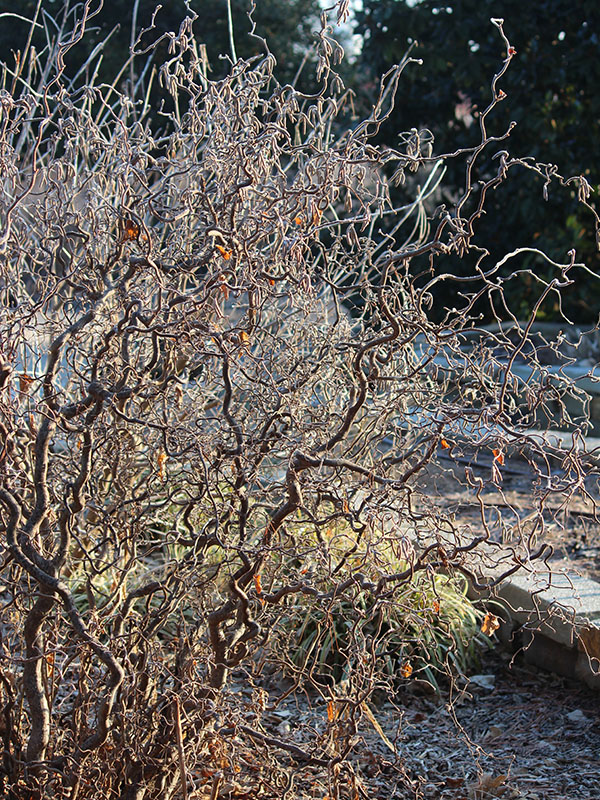 Harry Lauder’s Walkingstick or Contorted Filbert is a unique plant because of its
curly, twisty stems and foliage. The contorted stems add interest to the garden, especially
in winter after the leaves have fallen, when the contorted branches are best observed.
Late winter flowers (female tiny, inconspicuous flower with red stigmas and yellow-gray
male catkins which are somewhat showy) also add to the winter interest; fruits (nuts)
are seldom produced. The unique stems are prized by florists. It is a round, multi-trunked
shrub that can grow 8 foot to 10 foot tall. Plants are typically grafted onto non-contorted
species and may suckers. Suckers should be removed. Occasionally the contorted form
is grown on its own roots producing contorted suckers. Some cultivars have been developed
including dwarf cultivars which are perfect for small spaces as well as containers;
‘Red Dragon’, has maroon-colored leaves and reaches about 6 foot high and wide, ‘Red
Majestic’ also has maroon-colored leaves with a somewhat weeping habit.
Harry Lauder’s Walkingstick or Contorted Filbert is a unique plant because of its
curly, twisty stems and foliage. The contorted stems add interest to the garden, especially
in winter after the leaves have fallen, when the contorted branches are best observed.
Late winter flowers (female tiny, inconspicuous flower with red stigmas and yellow-gray
male catkins which are somewhat showy) also add to the winter interest; fruits (nuts)
are seldom produced. The unique stems are prized by florists. It is a round, multi-trunked
shrub that can grow 8 foot to 10 foot tall. Plants are typically grafted onto non-contorted
species and may suckers. Suckers should be removed. Occasionally the contorted form
is grown on its own roots producing contorted suckers. Some cultivars have been developed
including dwarf cultivars which are perfect for small spaces as well as containers;
‘Red Dragon’, has maroon-colored leaves and reaches about 6 foot high and wide, ‘Red
Majestic’ also has maroon-colored leaves with a somewhat weeping habit.
Exposure: Fun sun to part shade
Soil: Medium moisture, average garden, avoid heavy clays
Hardiness: USDA Zones 3 to 9
| Icon | Icon Description |
|---|---|
 |
Wildscape: Plant possesses one or more characteristics ideal for habitation by birds, butterflies or other animals. |
Japanese Kerria
Kerria japonica
Japanese kerria produces an abundance of yellow, rose-like flowers in the early spring
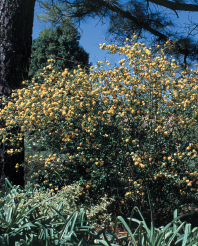 and sporadically through the summer. The species has single yellow flowers while ‘Pleniflora’
(shown here) has double flowers. In winter, Japanese kerria adds interest to the garden
with its bright green stems and arching habit. Japanese kerria can be rejuvenated
by cutting the shrub to the ground every few years.
and sporadically through the summer. The species has single yellow flowers while ‘Pleniflora’
(shown here) has double flowers. In winter, Japanese kerria adds interest to the garden
with its bright green stems and arching habit. Japanese kerria can be rejuvenated
by cutting the shrub to the ground every few years.
Exposure: Part to full shade
Soil: Well drained
Hardiness: USDA Zone 4
Juniper Collection
Juniperus virginiana ‘Taylor’
J. chinensis ‘Saybrook Gold’
J. horizontalis ‘Monber’
This collection represents the very diverse genus Juniperus, which has several species
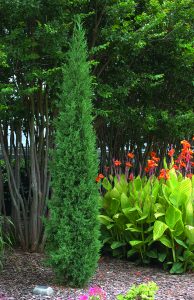 and many cultivars within each species. Junipers come in upright, spreading or low
groundcover forms. ‘Taylor’ is a narrow, upright cultivar that grows about 4 to 5
feet wide reaching 15 to 20 feet tall and is excellent for tight spaces. ‘Saybrook
Gold’ is the brightest gold, holding its color year round with a compact, spreading
habit to about 30 inches tall and 6 feet wide. ‘Monber’ Icee Blue® is a low, mat-forming
species with beautiful silver-blue foliage. In general, junipers are adapted to a
wide range of soils and withstand hot, dry conditions once established.
and many cultivars within each species. Junipers come in upright, spreading or low
groundcover forms. ‘Taylor’ is a narrow, upright cultivar that grows about 4 to 5
feet wide reaching 15 to 20 feet tall and is excellent for tight spaces. ‘Saybrook
Gold’ is the brightest gold, holding its color year round with a compact, spreading
habit to about 30 inches tall and 6 feet wide. ‘Monber’ Icee Blue® is a low, mat-forming
species with beautiful silver-blue foliage. In general, junipers are adapted to a
wide range of soils and withstand hot, dry conditions once established.
Exposure: Full sun to part shade
Soil: Moist, well drained
Hardiness: USDA Zones 4 to 9
| Icon | Icon Description |
|---|---|
 |
Wildscape: Plant possesses one or more characteristics ideal for habitation by birds, butterflies or other animals. |
Koreanspice Viburnum
Viburnum carlesii
Koreanspice viburnum is a small- to medium-sized shrub, offering year round interest.
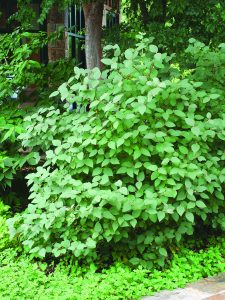 In summer, the leaves are dark green and fall color can be wine-red. Flower buds are
pink to red, opening to white or pink in spring and emit a wonderful fragrance. In
late summer, clusters of red fruit that fade to black invite birds to the garden.
Once the shrub has become established, it is quite heat and drought tolerant. Though
it prefers moist, slightly acidic soils, and sun to part shade, it is tolerant of
high pH soils and wind-swept conditions. It grows from 4 to 5 feet high and just as
broad. Several improved cultivars are available.
In summer, the leaves are dark green and fall color can be wine-red. Flower buds are
pink to red, opening to white or pink in spring and emit a wonderful fragrance. In
late summer, clusters of red fruit that fade to black invite birds to the garden.
Once the shrub has become established, it is quite heat and drought tolerant. Though
it prefers moist, slightly acidic soils, and sun to part shade, it is tolerant of
high pH soils and wind-swept conditions. It grows from 4 to 5 feet high and just as
broad. Several improved cultivars are available.
Exposure: Full sun to part shade
Soil: Moist, well drained
Hardiness: USDA Zones 5 to 7
| Icon | Icon Description |
|---|---|
 |
Native: Plant indigenous to the continental U.S. or a cultivar or hybrid derived from native plants. |
 |
Wildscape: Plant possesses one or more characteristics ideal for habitation by birds, butterflies or other animals. |
 |
Drought Resistant: After initial establishment period (up to two years), plant can withstand short-term drought. |
Mexican Buckeye
Ungnadia speciosa 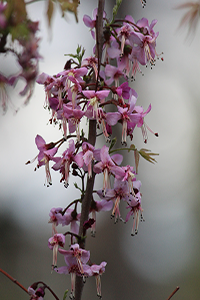
Mexican buckeye is a native, multi-stemmed large shrub or small tree reaching 15 to 30 feet high and about 20 feet wide. Its native range is west, central Texas to Mexico and New Mexico though it is hardy to zone 7. It is rapid-growing, drought-resistant, and resistant to cotton root rot. Its fragrant, pink flowers bloom simultaneously as it leafs out with light bronze-colored leaflets which turn pale green during the growing season. Its fall color is bright golden yellow. In its spring flowering aspect, it is thought to somewhat resemble eastern redbuds. Mexican buckeye’s round black somewhat shiny seeds are contained within a coarse, dark brown 3 valved capsule which somewhat resembles buckeye (Aesculus spp.) seeds. However, the two species are not related. Bees, butterflies, and other pollinators are attracted to the flowers. The seeds are eaten by birds and other mammals.
Exposure: Full sun to part shade
Soil: Neutral to alkaline and dry
Hardiness: USDA Zones 7 to 9
| Icon | Icon Description |
|---|---|
 |
Native: Plant indigenous to the continental U.S. or a cultivar or hybrid derived from native plants. |
 |
Wildscape: Plant possesses one or more characteristics ideal for habitation by birds, butterflies or other animals. |
 |
Drought Resistant: After initial establishment period (up to two years), plant can withstand short-term drought. |
 |
Collector's Choice: This plant will do well in Oklahoma but may need special placement or a little extra care. It will be very rewarding and impressive in the garden. |
Oakleaf Hydrangea
Hydrangea quercifolia
Oakleaf hydrangea produces beautiful, creamy-white, cone-shaped flowers in early  summer. This native shrub grows from 6 to 8 feet high and just as broad and has year-round
interest. In fall, the oak-shaped leaves can turn purple and red, and in winter, the
exfoliating bark is exposed as are the cinnamon-colored buds, that in late spring
and early summer open to form large, striking flowers. Various cultivars are available
and offer different aesthetic attributes.
summer. This native shrub grows from 6 to 8 feet high and just as broad and has year-round
interest. In fall, the oak-shaped leaves can turn purple and red, and in winter, the
exfoliating bark is exposed as are the cinnamon-colored buds, that in late spring
and early summer open to form large, striking flowers. Various cultivars are available
and offer different aesthetic attributes.
Exposure: Part shade
Soil: Moist, well drained
Hardiness: USDA Zone 5
| Icon | Icon Description |
|---|---|
 |
Native: Plant indigenous to the continental U.S. or a cultivar or hybrid derived from native plants. |
 |
Wildscape: Plant possesses one or more characteristics ideal for habitation by birds, butterflies or other animals. |
Pink Velour® Crapemyrtle
Lagerstroemia indica ‘Whit III’
Pink Velour® was developed in Oklahoma for its burgundy spring foliage. Summer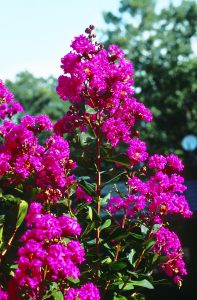 leaves have a dark purple cast and highlight the pink flowers that are formed from
early July until frost. Pink Velour® forms a 10-foot high, multi-stemmed large shrub, is drought tolerant and highly resistant
to powdery mildew.
leaves have a dark purple cast and highlight the pink flowers that are formed from
early July until frost. Pink Velour® forms a 10-foot high, multi-stemmed large shrub, is drought tolerant and highly resistant
to powdery mildew.
Exposure: Full sun
Soil: Moist, well drained
Hardiness: USDA Zone 6
| Icon | Icon Description |
|---|---|
 |
Drought Resistant: After initial establishment period (up to two years), plant can withstand short-term drought. |
Red Yucca
Hesperaloe parviflora 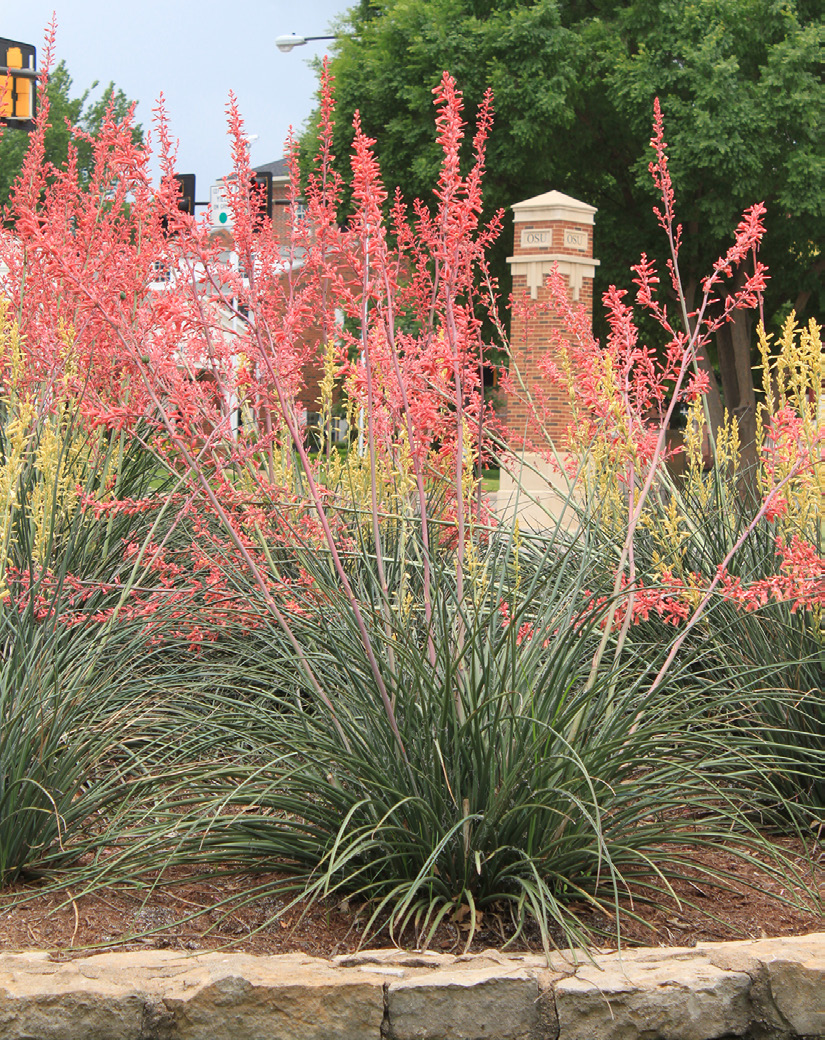
Not a yucca, this member of the Century-Plant family (Agavacea) produces soft, yucca-like evergreen leaves, 2 to 3 feet in length, crowded on the perennial's short, woody base. The flower stalk rises 5 feet and bears showy, coral-colored, tubular flowers on arching, wand-like, pink stems. Leaves are plum-colored in winter; blue-Green other times. Red Yucca is drought-resistant and adaptable to a variety of soils. Deer may browse the foliage while the flowers attract hummingbirds. Hesperaloe parviflora 'Perpa,' Brakelights® Red Yucca has vibrant, red blooms, which are great color improvement to this species! Yellow flowering forms are also available. Use in mass plantings for a dramatic effect in xeriscape and waterwise gardens. Good container specimen.
Exposure: Full sun
Soil: Dry, well drained
Hardiness: USDA Zones 5 to 10
| Icon | Icon Description |
|---|---|
 |
Native: Plant indigenous to the continental U.S. or a cultivar or hybrid derived from native plants. |
 |
Wildscape: Plant possesses one or more characteristics ideal for habitation by birds, butterflies or other animals. |
 |
Drought Resistant: After initial establishment period (up to two years), plant can withstand short-term drought. |
Seven-son-flower
Heptacodium miconioides
Seven-son-flower is an upright, irregular, loose and open shrub growing 15 to 20 feet
![]() high. Leaves appear in early spring are soft green and mature to dark green. It is
very attractive and pest free. Flower buds form in early summer, but do not open until
late summer or early fall. Individual flowers are tiny but fragrant and attract butterflies
to the garden. Sepals persist and change from green to rose-purple and are as attractive
as the flowers. Bark is exfoliating, whitish, to rich brown and green. Seven-son-flower
grows best in moist, well-drained, acidic soil, but seems adaptable.
high. Leaves appear in early spring are soft green and mature to dark green. It is
very attractive and pest free. Flower buds form in early summer, but do not open until
late summer or early fall. Individual flowers are tiny but fragrant and attract butterflies
to the garden. Sepals persist and change from green to rose-purple and are as attractive
as the flowers. Bark is exfoliating, whitish, to rich brown and green. Seven-son-flower
grows best in moist, well-drained, acidic soil, but seems adaptable.
Exposure: Full sun to part shade
Soil: Moist, well drained
Hardiness: USDA Zones 5 to 8
| Icon | Icon Description |
|---|---|
 |
Wildscape: Plant possesses one or more characteristics ideal for habitation by birds, butterflies or other animals. |
 |
Drought Resistant: After initial establishment period (up to two years), plant can withstand short-term drought. |
 |
Collector's Choice: This plant will do well in Oklahoma but may need special placement or a little extra care. It will be very rewarding and impressive in the garden. |
Southern Waxmyrtle
Myrica cerifera
Southern waxmyrtle is a broad-leaved evergreen native to the southeast corner of Oklahoma
and along much of the eastern coastal plain. It has been described as the 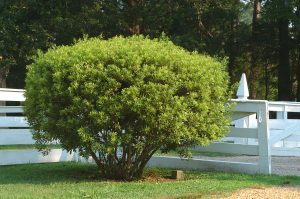 southern cousin of bayberry and has a similar scent when new leaves emerge in spring.
It produces small but showy blue fruit. Southern waxmyrtle can be grown as a large
shrub, making an excellent naturalistic screen, or can be pruned to tree form, exposing
its light-gray bark. It fixes atmospheric nitrogen, making it suitable on poor soils;
it withstands bog-like conditions. Narrow leaf, compact and dwarf cultivars are available,
extending the possible uses for this native shrub.
southern cousin of bayberry and has a similar scent when new leaves emerge in spring.
It produces small but showy blue fruit. Southern waxmyrtle can be grown as a large
shrub, making an excellent naturalistic screen, or can be pruned to tree form, exposing
its light-gray bark. It fixes atmospheric nitrogen, making it suitable on poor soils;
it withstands bog-like conditions. Narrow leaf, compact and dwarf cultivars are available,
extending the possible uses for this native shrub.
Exposure: Full sun to part shade
Soil: Tolerant of most soils
Hardiness: USDA Zone 7
| Icon | Icon Description |
|---|---|
 |
Native: Plant indigenous to the continental U.S. or a cultivar or hybrid derived from native plants. |
 |
Wildscape: Plant possesses one or more characteristics ideal for habitation by birds, butterflies or other animals. |
Specialty Fruit for Small Spaces
Miniature peaches, columnar apples, dwarf pomegranate and dwarf patio-type blueberries
Many of the fruits we enjoy so much do not fit well in today’s urban 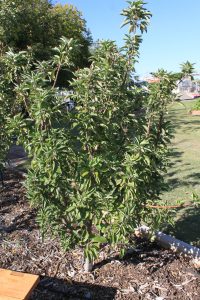 landscapes, especially the standard variety fruit trees. However, today’s breeding
and production techniques bring us dwarf and miniature versions that fit in just about
any space. Columnar apples, patio peaches, dwarf pomegranates and compact blueberries
now make easy to enjoy fresh fruit right out our back door; and they are ornamental
too!
landscapes, especially the standard variety fruit trees. However, today’s breeding
and production techniques bring us dwarf and miniature versions that fit in just about
any space. Columnar apples, patio peaches, dwarf pomegranates and compact blueberries
now make easy to enjoy fresh fruit right out our back door; and they are ornamental
too!
Exposure: Full sun to part shade
Soil: Prefers moist, well drained; blueberries require acidic soil (pH 5)
Hardiness: USDA Zones 3 to 11 (varies by species)
| Icon | Icon Description |
|---|---|
 |
Collector's Choice: This plant will do well in Oklahoma but may need special placement or a little extra care. It will be very rewarding and impressive in the garden. |
Spirea
Spiraea japonica ‘Magic Carpet’
‘Magic Carpet’ spirea is a compact cultivar from 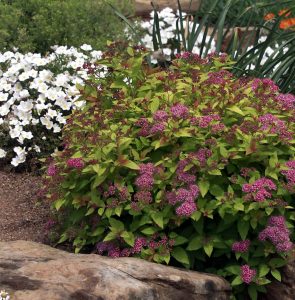 England with dark pink flowers and reddish shoots bearing gold-tinged young foliage
in spring. This shrub will remain compact, making it perfect for mixed borders, rock
gardens or small-scale landscapes.
England with dark pink flowers and reddish shoots bearing gold-tinged young foliage
in spring. This shrub will remain compact, making it perfect for mixed borders, rock
gardens or small-scale landscapes.
Exposure: Full sun
Soil: Moist, well drained
Hardiness: USDA Zone 4
Sumac
Rhus typhina
Many sumacs are native to Oklahoma, and these selections have unique characteristics.
Tiger Eyes® is bright lime green to yellow all summer, turning brilliant bronzy red
in 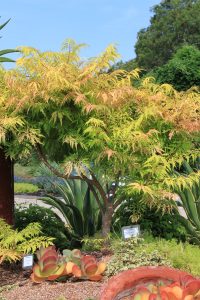 fall. Tiger Eyes® can grow 6 to 7 feet high. ‘Laciniata’ or laceleaf sumac has deeply
divided leaflets that create a fine-textured, lacey appearance and turn shades of
red, orange and yellow in fall. This cultivar can grow 10 to 15 feet tall. As with
any other sumac, they spread by suckers forming thickets. Fruit form in pyramidal
clusters and are hairy, red, berry-like drupes that persist into winter, providing
interest and food for wildlife. Flowers that bloom in spring attract bees and butterflies.
These selections of sumac are all great for naturalized areas and erosion control.
fall. Tiger Eyes® can grow 6 to 7 feet high. ‘Laciniata’ or laceleaf sumac has deeply
divided leaflets that create a fine-textured, lacey appearance and turn shades of
red, orange and yellow in fall. This cultivar can grow 10 to 15 feet tall. As with
any other sumac, they spread by suckers forming thickets. Fruit form in pyramidal
clusters and are hairy, red, berry-like drupes that persist into winter, providing
interest and food for wildlife. Flowers that bloom in spring attract bees and butterflies.
These selections of sumac are all great for naturalized areas and erosion control.
Exposure: Full sun to part shade
Soil: Moist, well drained; tolerant of high pH soils and pollution
Hardiness: USDA Zones 3 to 7
| Icon | Icon Description |
|---|---|
 |
Native: Plant indigenous to the continental U.S. or a cultivar or hybrid derived from native plants. |
 |
Wildscape: Plant possesses one or more characteristics ideal for habitation by birds, butterflies or other animals. |
 |
Drought Resistant: After initial establishment period (up to two years), plant can withstand short-term drought. |
 |
Collector's Choice: This plant will do well in Oklahoma but may need special placement or a little extra care. It will be very rewarding and impressive in the garden. |
Variegated Yucca
Yucca filamentosa ‘Color Guard’
Yucca is virtually a stemless evergreen shrub native to the southeast.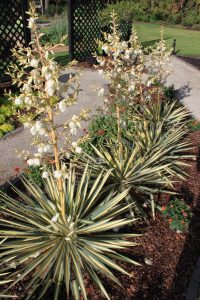 ‘Color Guard’ is a gold-centered, variegated form with upright sword-shaped leaves
that provide striking architectural features to the garden. Flowering stalks arise
in late spring from the center of the plant bearing long, terminal panicles of bell-shaped,
nodding, fragrant, creamy white flowers. ‘Color Guard’ yucca is free of pests and
is tolerant of dry areas. It is excellent in borders, xeriscape plantings, containers
and as an accent plant.
‘Color Guard’ is a gold-centered, variegated form with upright sword-shaped leaves
that provide striking architectural features to the garden. Flowering stalks arise
in late spring from the center of the plant bearing long, terminal panicles of bell-shaped,
nodding, fragrant, creamy white flowers. ‘Color Guard’ yucca is free of pests and
is tolerant of dry areas. It is excellent in borders, xeriscape plantings, containers
and as an accent plant.
Exposure: Full sun to part shade
Soil: Dry to moist, well drained
Hardiness: USDA Zones 3 to 8
| Icon | Icon Description |
|---|---|
 |
Native: Plant indigenous to the continental U.S. or a cultivar or hybrid derived from native plants. |
 |
Wildscape: Plant possesses one or more characteristics ideal for habitation by birds, butterflies or other animals. |
 |
Drought Resistant: After initial establishment period (up to two years), plant can withstand short-term drought. |
Virginia Sweetspire
Itea virginica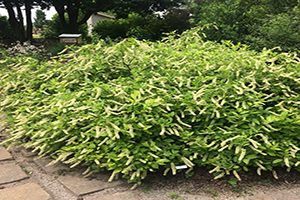
Virginia sweetspire is a native shrub to eastern Oklahoma but does well in throughout the state. It is a mound-shaped, slender-branched, deciduous shrub generally 3 to 6 feet tall and wide. Small, white, fragrant flowers bloom in spring to early summer in 4-inch spires that droop with the arching branches. Flowers open from base to tip so that the plant appears to bloom for a long time. Leaves turn red to purple in fall and persist well into the winter. Plants are found growing in the wild in moist, even wet to swampy areas and along stream banks, in acid soils, but they are not too picky of the soil type. Plants should be watered during droughts. Virginia sweetspire grows in shady areas as an understory plant, but it grows best and has better blooms and fall color if it receives full sun for at least part of the day.
Exposure: Part shade to full sun
Soil: Moist, acidic; tolerates poor drainage
Hardiness: USDA Zone 5 to 9
| Icon | Icon Description |
|---|---|
 |
Native: Plant indigenous to the continental U.S. or a cultivar or hybrid derived from native plants. |
 |
Wildscape: Plant possesses one or more characteristics ideal for habitation by birds, butterflies or other animals. |
Winterberry Holly (Dwarf Cultivars)
Ilex verticillata
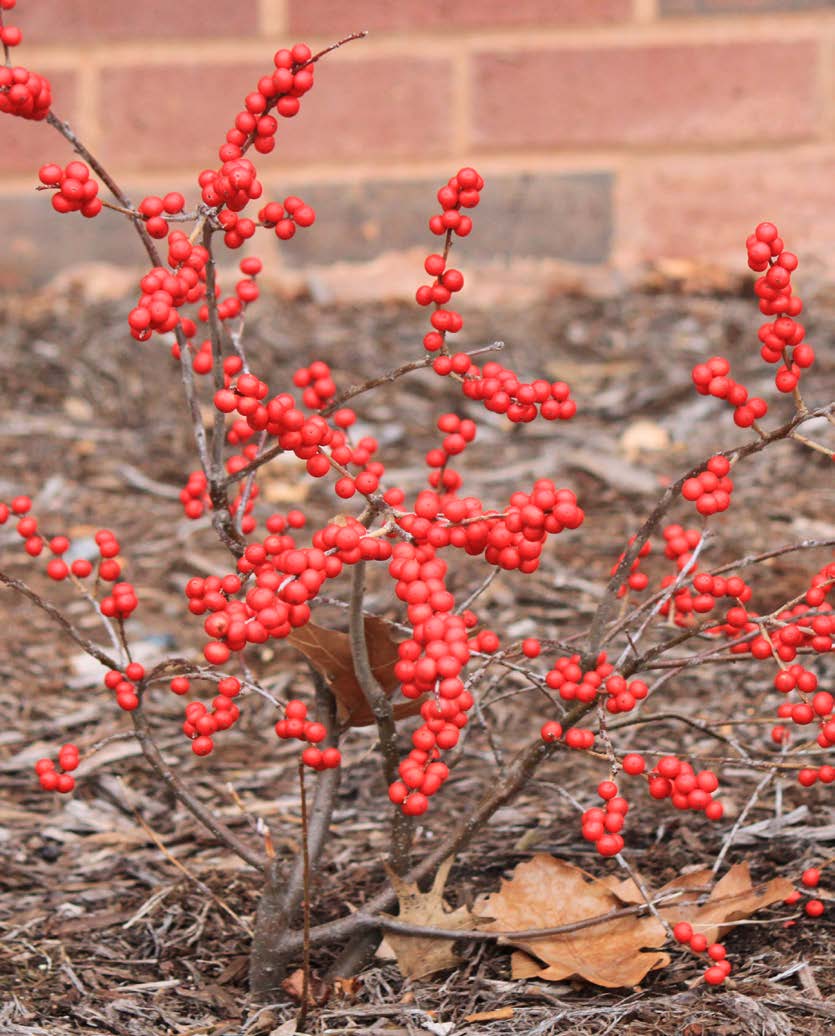 Common winterberry is a deciduous holly native of Eastern North America. Inconspicuous
flowers are followed by dense clusters of bright red berries that persist on branches
throughout winter, providing a spectacular winter display. The species is a globular,
upright, medium-sized shrub, typically 6 to 10 ft. tall, but dwarf cultivars have
been developed, which are perfect for small spaces and containers. Birds are readily
attracted to the fruit. This shrub grows in both wet and dry sites for naturalized
areas. Dwarf cultivars are great for small hedges, a cutting garden, mass plantings
and containers.
Common winterberry is a deciduous holly native of Eastern North America. Inconspicuous
flowers are followed by dense clusters of bright red berries that persist on branches
throughout winter, providing a spectacular winter display. The species is a globular,
upright, medium-sized shrub, typically 6 to 10 ft. tall, but dwarf cultivars have
been developed, which are perfect for small spaces and containers. Birds are readily
attracted to the fruit. This shrub grows in both wet and dry sites for naturalized
areas. Dwarf cultivars are great for small hedges, a cutting garden, mass plantings
and containers.
Exposure: Full sun to part shade
Soil: Moist, well drained, acidic
Hardiness: USDA Zones 3 to 9
| Icon | Icon Description |
|---|---|
 |
Native: Plant indigenous to the continental U.S. or a cultivar or hybrid derived from native plants. |
 |
Wildscape: Plant possesses one or more characteristics ideal for habitation by birds, butterflies or other animals. |
Winter Jasmine
Jasminum nudiflorum 
Winter jasmine is often mistaken for Forsythia, but it flowers earlier and has a long-lasting floral display. It flowers as early as December before its glossy green leaves are formed. Winter jasmine is routinely semi-evergreen in Oklahoma. It can be pruned and used as a hedge, but left untrimmed, will arch gracefully forming a 4-foot-high mound spreading to 7 feet. Winter jasmine requires very little care and is easily rejuvenated by cutting it to the ground every three to five years.
Exposure: Full sun to part shade
Soil: Tolerant of most soils
Hardiness: USDA Zone 6
| Icon | Icon Description |
|---|---|
 |
Wildscape: Plant possesses one or more characteristics ideal for habitation by birds, butterflies or other animals. |
 |
Drought Resistant: After initial establishment period (up to two years), plant can withstand short-term drought. |
Trees
American Elm
Ulmus americana
With the release of improved, disease-resistant cultivars and hybrids, American elms
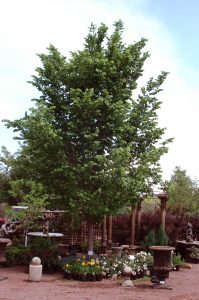 are once again in demand. ‘Valley Forge,’ ‘New Harmony’ and ‘Princeton’ are a few
of the cultivars available today. ‘Valley Forge’ is upright, arching, broadly vase-shaped
with a full, dense canopy. ‘New Harmony’ develops into a broad vase-shaped crown with
arching branches terminating in numerous slender, often drooping branchlets. ‘Princeton’
is also vase-shaped. American elms are adapted to a wide variety of soil conditions,
tolerate de-icing salts, air pollution, drought and a range of soil pH. They have
yellow or red fall color.
are once again in demand. ‘Valley Forge,’ ‘New Harmony’ and ‘Princeton’ are a few
of the cultivars available today. ‘Valley Forge’ is upright, arching, broadly vase-shaped
with a full, dense canopy. ‘New Harmony’ develops into a broad vase-shaped crown with
arching branches terminating in numerous slender, often drooping branchlets. ‘Princeton’
is also vase-shaped. American elms are adapted to a wide variety of soil conditions,
tolerate de-icing salts, air pollution, drought and a range of soil pH. They have
yellow or red fall color.
Exposure: Full sun to part shade
Soil: Well drained
Hardiness: USDA Zones 5 to 9
| Icon | Icon Description |
|---|---|
 |
Wildscape: Plant possesses one or more characteristics ideal for habitation by birds, butterflies or other animals. |
 |
Drought Resistant: After initial establishment period (up to two years), plant can withstand short-term drought. |
Arizona Cypress
Cupressus arizonica
Arizona cypress is a drought tolerant, evergreen tree native to southwestern  U.S. In the landscape, it usually reaches a height of only 20 to 25 feet and 15 feet
wide. The foliage can be a gray-green, but usually blueish. Recently, yellow-foliage
forms are available. ‘Blue Ice’ and ‘Carolina Sapphire’ are common cultivars and ‘Cookes
Peak’ is a selection from Cookes Peak, New Mexico with silvery-blue foliage and pyramidal
form. Arizona cypress require well-drained soil and thrive in hot, dry environments.
As the tree ages, the bark exfoliates beautifully, becoming mottled with patches of
burnt orange and green.
U.S. In the landscape, it usually reaches a height of only 20 to 25 feet and 15 feet
wide. The foliage can be a gray-green, but usually blueish. Recently, yellow-foliage
forms are available. ‘Blue Ice’ and ‘Carolina Sapphire’ are common cultivars and ‘Cookes
Peak’ is a selection from Cookes Peak, New Mexico with silvery-blue foliage and pyramidal
form. Arizona cypress require well-drained soil and thrive in hot, dry environments.
As the tree ages, the bark exfoliates beautifully, becoming mottled with patches of
burnt orange and green.
Exposure: Full sun
Soil: Well drained
Hardiness: USDA Zone 7
| Icon | Icon Description |
|---|---|
 |
Native: Plant indigenous to the continental U.S. or a cultivar or hybrid derived from native plants. |
 |
Drought Resistant: After initial establishment period (up to two years), plant can withstand short-term drought. |
Bald Cypress
Taxodium distichum
This large Oklahoma native will lose its leaves in the fall after turning a 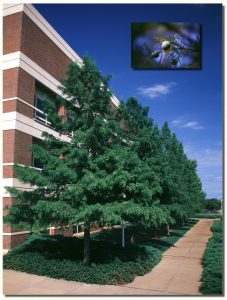 russet or coppery-bronze and can easily grow to 70 feet high with a 30-foot spread,
however, narrow growth habit and dwarf selections are also available. Tolerant of
both wet and dry soils, bald cypress makes an outstanding specimen, street tree or
pond-side grove.
russet or coppery-bronze and can easily grow to 70 feet high with a 30-foot spread,
however, narrow growth habit and dwarf selections are also available. Tolerant of
both wet and dry soils, bald cypress makes an outstanding specimen, street tree or
pond-side grove.
Exposure: Full sun
Soil: Well drained to flood tolerant
Hardiness: USDA Zone 4
| Icon | Icon Description |
|---|---|
 |
Native: Plant indigenous to the continental U.S. or a cultivar or hybrid derived from native plants. |
 |
Wildscape: Plant possesses one or more characteristics ideal for habitation by birds, butterflies or other animals. |
 |
Drought Resistant: After initial establishment period (up to two years), plant can withstand short-term drought. |
Black Gum
Nyssa sylvatica
Black gum is an eastern native, growing slowly to 50 to 60 feet high or more. They
are picturesque shade trees with beautiful summer foliage and gorgeous fall color.
New selections have excellent form and are more resistant to leaf spot, which can
occasionally be a problem. ‘Wildfire’ (N. sylvatica ) grows slowly to 60 feet high
by 25 feet wide. New growth emerges red; leaves mature to a shiny dark green; and fall
color is bright red. Fire Master™ (N. sylvatica ‘PRP1’) grows about 50 to 60 feet
tall and 25 feet wide with a strong central leader; leaves turn crimson red in the
fall. Red Rage™ (N. sylvatica ‘Hayman Red’) exhibits more leaf spot resistance than
other cultivars and is slightly smaller, growing 30 to 50 feet tall. Flowers of black
gum are insignificant, but an important nectar source for bees and pollinators. The
small, black fruits that follow are loved by birds. Black gums are an excellent tree
for urban and street plantings and their neat habit requires little to no pruning
to maintain their excellent shape.
25 feet wide. New growth emerges red; leaves mature to a shiny dark green; and fall
color is bright red. Fire Master™ (N. sylvatica ‘PRP1’) grows about 50 to 60 feet
tall and 25 feet wide with a strong central leader; leaves turn crimson red in the
fall. Red Rage™ (N. sylvatica ‘Hayman Red’) exhibits more leaf spot resistance than
other cultivars and is slightly smaller, growing 30 to 50 feet tall. Flowers of black
gum are insignificant, but an important nectar source for bees and pollinators. The
small, black fruits that follow are loved by birds. Black gums are an excellent tree
for urban and street plantings and their neat habit requires little to no pruning
to maintain their excellent shape.
Exposure: Full sun to part shade
Soil: Average to wet
Hardiness: USDA Zones 4 to 9
| Icon | Icon Description |
|---|---|
 |
Native: Plant indigenous to the continental U.S. or a cultivar or hybrid derived from native plants. |
 |
Wildscape: Plant possesses one or more characteristics ideal for habitation by birds, butterflies or other animals. |
 |
Drought Resistant: After initial establishment period (up to two years), plant can withstand short-term drought. |
 |
Collector's Choice: This plant will do well in Oklahoma but may need special placement or a little extra care. It will be very rewarding and impressive in the garden. |
Bosnian Pine
Pinus heldreichii
Bosnian pine is a slow-growing evergreen with a dense pyramidal form when young. It
has the potential to grow to 70 feet tall in its native environment, but is more likely
to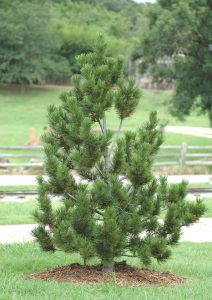 reach only 25 to 30 feet in the landscape. In the Pirin Mountains of Bulgaria, there
is a 70-foot tall Bosnian pine estimated to be over 1,300 years old! Young cones are
purple and turn brown as they mature. The seeds they produce are edible. Bosnian pine
prefers full sun and, once established, is quite tolerant of high pH soils and drought.
It is also disease resistant and can be used in the landscape where an evergreen or
pine is desired and space is limited.
reach only 25 to 30 feet in the landscape. In the Pirin Mountains of Bulgaria, there
is a 70-foot tall Bosnian pine estimated to be over 1,300 years old! Young cones are
purple and turn brown as they mature. The seeds they produce are edible. Bosnian pine
prefers full sun and, once established, is quite tolerant of high pH soils and drought.
It is also disease resistant and can be used in the landscape where an evergreen or
pine is desired and space is limited.
Exposure: Full sun
Soil: Tolerates dry and high pH soils
Hardiness: USDA Zone 6
| Icon | Icon Description |
|---|---|
 |
Drought Resistant: After initial establishment period (up to two years), plant can withstand short-term drought. |
Bur Oak
Quercus macrocarpa
Bur oak is an Oklahoma native that can grow to 60 feet tall, 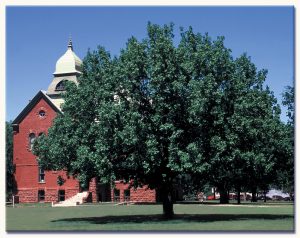 with an even larger spread, and can tolerate drought, heavy soils and high pH soils.
Bur oak can grow to be a long-lived, majestic specimen and is an important wildlife
species since many animals feed on its large acorns.
with an even larger spread, and can tolerate drought, heavy soils and high pH soils.
Bur oak can grow to be a long-lived, majestic specimen and is an important wildlife
species since many animals feed on its large acorns.
Exposure: Full sun
Soil: Tolerant of most soils
Hardiness: USDA Zone 3
| Icon | Icon Description |
|---|---|
 |
Native: Plant indigenous to the continental U.S. or a cultivar or hybrid derived from native plants. |
 |
Wildscape: Plant possesses one or more characteristics ideal for habitation by birds, butterflies or other animals. |
 |
Drought Resistant: After initial establishment period (up to two years), plant can withstand short-term drought. |
Caddo Sugar Maple
Acer saccharum 'Caddo'
Caddo sugar maple is a native population of sugar maple found growing in Caddo County
in southwestern Oklahoma. The leaves are dark green, deeply lobed and 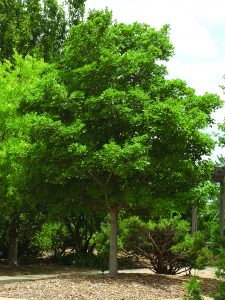 leathery, making it more resistant to leaf tatter and scorch. Caddo sugar maple is
also quite tolerant of high pH soils, extreme heat and drought conditions commonly
found in western Oklahoma. It can reach 30 to 50 feet tall and is a beautiful medium
to large shade tree. Fall color is variable, but can range from yellow to golden yellow
to orange and sometimes red; cultivars selected for brilliant fall colors as well
as outstanding performance are available.
leathery, making it more resistant to leaf tatter and scorch. Caddo sugar maple is
also quite tolerant of high pH soils, extreme heat and drought conditions commonly
found in western Oklahoma. It can reach 30 to 50 feet tall and is a beautiful medium
to large shade tree. Fall color is variable, but can range from yellow to golden yellow
to orange and sometimes red; cultivars selected for brilliant fall colors as well
as outstanding performance are available.
Exposure: Full sun
Soil: Well drained
Hardiness: USDA Zones 5 to 9
| Icon | Icon Description |
|---|---|
 |
Native: Plant indigenous to the continental U.S. or a cultivar or hybrid derived from native plants. |
 |
Drought Resistant: After initial establishment period (up to two years), plant can withstand short-term drought. |
 |
Collector's Choice: This plant will do well in Oklahoma but may need special placement or a little extra care. It will be very rewarding and impressive in the garden. |
Cedar Elm
Ulmus crassifolia
Cedar elm can thrive in almost any soil type, including the alkaline and heavy soils
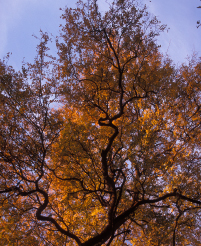 common in Oklahoma. It is one of the more disease-resistant native elms, producing
glossy green leaves in early spring that turn a muted yellow in the fall. Its form
can vary from upright-oval to broadly-horizontal and it generally matures around 60
feet tall. It can be distinguished from other elms by its rough-textured leaves, corky
projections on young stems and flowers and fruit produced in the fall.
common in Oklahoma. It is one of the more disease-resistant native elms, producing
glossy green leaves in early spring that turn a muted yellow in the fall. Its form
can vary from upright-oval to broadly-horizontal and it generally matures around 60
feet tall. It can be distinguished from other elms by its rough-textured leaves, corky
projections on young stems and flowers and fruit produced in the fall.
Exposure: Full sun
Soil: Tolerant of most soils
Hardiness: USDA Zone 6
| Icon | Icon Description |
|---|---|
 |
Native: Plant indigenous to the continental U.S. or a cultivar or hybrid derived from native plants. |
 |
Wildscape: Plant possesses one or more characteristics ideal for habitation by birds, butterflies or other animals. |
 |
Drought Resistant: After initial establishment period (up to two years), plant can withstand short-term drought. |
Chinese Pistache
Pistacia chinensis
Chinese pistache reaches a height of 30 to 45 feet with 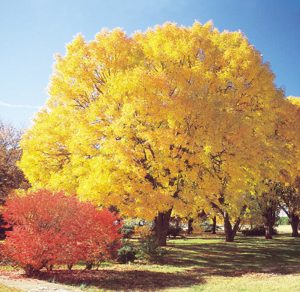 only a slightly smaller spread. Brilliant yellow, orange or red leaves reliably grace
the tree in autumn. Chinese pistache is a tough tree tolerant of drought, heat and
heavy soils.
only a slightly smaller spread. Brilliant yellow, orange or red leaves reliably grace
the tree in autumn. Chinese pistache is a tough tree tolerant of drought, heat and
heavy soils.
Exposure: Full sun
Soil: Tolerant of most soils
Hardiness: USDA Zone 6
| Icon | Icon Description |
|---|---|
 |
Wildscape: Plant possesses one or more characteristics ideal for habitation by birds, butterflies or other animals. |
 |
Drought Resistant: After initial establishment period (up to two years), plant can withstand short-term drought. |
Chinkapin Oak
Quercus muehlenbergii
A native oak growing throughout most of Oklahoma and eastward, chinkapin oak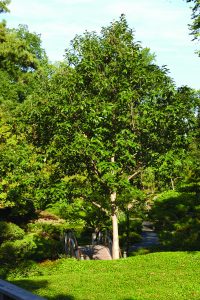 is a rather attractive shade tree that grows 40 to 50 feet high and wide in the landscape.
The tree has a nice medium texture in summer and a medium-coarse texture in winter.
Bark on the stems and trunk develop into irregular blocky scales with age and is quite
attractive. Leaves are a glossy, dark yellow-green in summer with varying fall color
of yellow to orange-brown to brown. Chinkapin oak is adapted to various soils, even
alkaline soils and is quite drought resistant and tolerant of windswept sites.
is a rather attractive shade tree that grows 40 to 50 feet high and wide in the landscape.
The tree has a nice medium texture in summer and a medium-coarse texture in winter.
Bark on the stems and trunk develop into irregular blocky scales with age and is quite
attractive. Leaves are a glossy, dark yellow-green in summer with varying fall color
of yellow to orange-brown to brown. Chinkapin oak is adapted to various soils, even
alkaline soils and is quite drought resistant and tolerant of windswept sites.
Exposure: Full sun to part shade
Soil: Well drained
Hardiness: USDA Zones 5 to 9
| Icon | Icon Description |
|---|---|
 |
Native: Plant indigenous to the continental U.S. or a cultivar or hybrid derived from native plants. |
 |
Wildscape: Plant possesses one or more characteristics ideal for habitation by birds, butterflies or other animals. |
 |
Drought Resistant: After initial establishment period (up to two years), plant can withstand short-term drought. |
Crabapple
Malus ‘Prairifire’
Few trees have as much year-round interest as the crabapple, and few 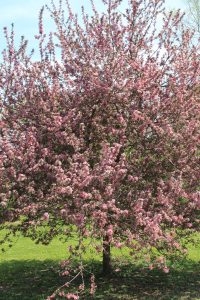 crabapples are as beautiful and disease resistant as ‘Prairifire.’ ‘Prairifire’ starts
the spring with a profusion of rose-pink flowers just as the leaves emerge. As summer
progresses, the leaves turn from purple-red to dark green and red fruit forms that
persists well into the winter. It is resistant to diseases that affect many crabapples.
It has a rounded crown and will not exceed 20 feet tall, which makes it a perfect
choice for planting under utility lines or in masses.
crabapples are as beautiful and disease resistant as ‘Prairifire.’ ‘Prairifire’ starts
the spring with a profusion of rose-pink flowers just as the leaves emerge. As summer
progresses, the leaves turn from purple-red to dark green and red fruit forms that
persists well into the winter. It is resistant to diseases that affect many crabapples.
It has a rounded crown and will not exceed 20 feet tall, which makes it a perfect
choice for planting under utility lines or in masses.
Exposure: Full sun
Soil: Well drained
Hardiness: USDA Zone 4
| Icon | Icon Description |
|---|---|
 |
Wildscape: Plant possesses one or more characteristics ideal for habitation by birds, butterflies or other animals. |
 |
Drought Resistant: After initial establishment period (up to two years), plant can withstand short-term drought. |
Deciduous Magnolia Cultivars
Magnolia
Deciduous forms of magnolia are spectacular additions to any spring landscape. Among
the most popular of deciduous forms are star magnolia (M. stellata) and saucer 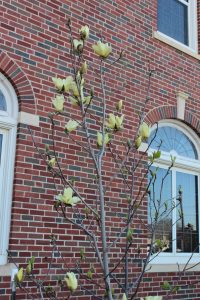 magnolia (M. x soulangiana), but several others are available along with their many
hybrids, which provide a wide variety of flower colors from red to white, yellow,
pink or purple. The most common color available is pink, but others such as ‘Elizabeth,’
an older selection with creamy yellow flowers, or ‘Butterflies,’ a newer selection
with deep yellow flowers. Flowers of deciduous magnolias appear just before or while
the leaves are emerging in spring. Early flowering varieties can be damaged by late
frosts; avoid placing plants in a southern exposure where flowers will open early.
Deciduous magnolias can range in size from small to medium shrubs to large trees.
magnolia (M. x soulangiana), but several others are available along with their many
hybrids, which provide a wide variety of flower colors from red to white, yellow,
pink or purple. The most common color available is pink, but others such as ‘Elizabeth,’
an older selection with creamy yellow flowers, or ‘Butterflies,’ a newer selection
with deep yellow flowers. Flowers of deciduous magnolias appear just before or while
the leaves are emerging in spring. Early flowering varieties can be damaged by late
frosts; avoid placing plants in a southern exposure where flowers will open early.
Deciduous magnolias can range in size from small to medium shrubs to large trees.
Exposure: Full sun to part shade
Soil: Prefers moist, well drained, acidic, but is adaptable
Hardiness: USDA Zones 4 to 9
| Icon | Icon Description |
|---|---|
 |
Collector's Choice: This plant will do well in Oklahoma but may need special placement or a little extra care. It will be very rewarding and impressive in the garden. |
Desert-willow
Chilopsis linearis
Desert-willow is not a willow at all. It prefers dry, well-drained soils, compared
to true willows, which grow along streams and ponds; in fact, it will not tolerate
heavy, wet  soils. Because it likes the hotter, drier climates, it is an excellent choice for
western Oklahoma. Desert-willow grows as a small tree 15 to 30 feet high and 10 to
25 feet wide. It is a loose, gangly tree favored for its colorful, funnel-shaped flowers
that put on their biggest show in early summer, then bloom sporadically throughout
the rest of summer. Flowers can be white, pink, rose or lavender with purple markings
inside and are sweetly fragrant. Foliage is a rich green in summer with no fall color,
falling early to reveal the interesting branching structure. Several cultivars exist.
Desert-willow makes a great patio or small specimen tree and attracts hummingbirds
and other birds.
soils. Because it likes the hotter, drier climates, it is an excellent choice for
western Oklahoma. Desert-willow grows as a small tree 15 to 30 feet high and 10 to
25 feet wide. It is a loose, gangly tree favored for its colorful, funnel-shaped flowers
that put on their biggest show in early summer, then bloom sporadically throughout
the rest of summer. Flowers can be white, pink, rose or lavender with purple markings
inside and are sweetly fragrant. Foliage is a rich green in summer with no fall color,
falling early to reveal the interesting branching structure. Several cultivars exist.
Desert-willow makes a great patio or small specimen tree and attracts hummingbirds
and other birds.
Exposure: Full sun
Soil: Dry, well drained
Hardiness: USDA Zones 7 to 9
| Icon | Icon Description |
|---|---|
 |
Native: Plant indigenous to the continental U.S. or a cultivar or hybrid derived from native plants. |
 |
Wildscape: Plant possesses one or more characteristics ideal for habitation by birds, butterflies or other animals. |
 |
Drought Resistant: After initial establishment period (up to two years), plant can withstand short-term drought. |
Escarpment Live Oak
Quercus fusiformis
Escarpment live oak is a smaller version of the coastal live oak (Q. virginiana).
It grows 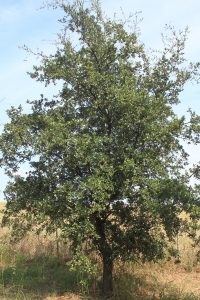 slowly to 20 to 40 feet high and about as wide with picturesquely gnarled branches
and evergreen leaves. Escarpment live oak is native to southern Oklahoma through central
and western Texas to northern Mexico, which means it is also more drought and cold
tolerant than coastal live oak. Because of its slower growth, it is a perfect long-lived
shade tree for smaller, urban landscapes. Branches provide excellent nesting sites
for birds and small mammals. Acorns are elongated and eaten by wildlife. It is also
the larval host of the hairstreak and Horace’s duskywing butterflies.
slowly to 20 to 40 feet high and about as wide with picturesquely gnarled branches
and evergreen leaves. Escarpment live oak is native to southern Oklahoma through central
and western Texas to northern Mexico, which means it is also more drought and cold
tolerant than coastal live oak. Because of its slower growth, it is a perfect long-lived
shade tree for smaller, urban landscapes. Branches provide excellent nesting sites
for birds and small mammals. Acorns are elongated and eaten by wildlife. It is also
the larval host of the hairstreak and Horace’s duskywing butterflies.
Exposure: Full sun to part shade
Soil: Alkaline to slightly acidic, well drained
Hardiness: USDA Zones 6 to 10
| Icon | Icon Description |
|---|---|
 |
Native: Plant indigenous to the continental U.S. or a cultivar or hybrid derived from native plants. |
 |
Wildscape: Plant possesses one or more characteristics ideal for habitation by birds, butterflies or other animals. |
 |
Drought Resistant: After initial establishment period (up to two years), plant can withstand short-term drought. |
Fringetree
Chionanthus cultivars
Chionanthus virginicus is a deciduous, native shrub or small tree with a spreading,
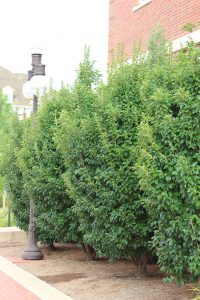 rounded habit that typically grows 12 to 20 feet tall. It occurs most often in rich,
moist woods and hillsides and moist stream banks. The common name fringetree refers
to the slightly fragrant, spring flowers which feature airy, terminal, drooping clusters
of fringe-like, creamy white petals. Fringetrees are dioecious (separate male and
female plants), but also may have perfect flowers on each plant. Male flowers are
showier than female flowers. Plants with perfect or female flowers may give way to
clusters of olive-like fruits which ripen to a dark, bluish black in late summer and
are a food source for birds and wildlife. Cultivars from the Chinese cousin, C. retusus (shown
here), also are available.
rounded habit that typically grows 12 to 20 feet tall. It occurs most often in rich,
moist woods and hillsides and moist stream banks. The common name fringetree refers
to the slightly fragrant, spring flowers which feature airy, terminal, drooping clusters
of fringe-like, creamy white petals. Fringetrees are dioecious (separate male and
female plants), but also may have perfect flowers on each plant. Male flowers are
showier than female flowers. Plants with perfect or female flowers may give way to
clusters of olive-like fruits which ripen to a dark, bluish black in late summer and
are a food source for birds and wildlife. Cultivars from the Chinese cousin, C. retusus (shown
here), also are available.
Exposure: Full sun to part shade
Soil: Tolerant of most soils
Hardiness: USDA Zones 5 to 8
| Icon | Icon Description |
|---|---|
 |
Wildscape: Plant possesses one or more characteristics ideal for habitation by birds, butterflies or other animals. |
Ginkgo or Maidenhair Tree
Ginkgo biloba 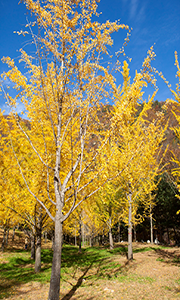
Ginkgo or Maidenhair tree is a unique tree in that its leaves are somewhat leathery, fan-shaped, with two distinctive lobes, and have almost parallel veins. The species can reach 50 to 80 feet high and 30 to 40 feet wide in ideal conditions, but they are very slow growers, and it takes decades for them to reach mature height. Ginkgo is not very picky of its growing conditions and is quite tolerant of a wide range of soil conditions and is even a great choice for the urban environment due to its tolerance to compacted soils, heat, and air pollution. Leaves of ginkgo are bright green in summer turning a beautiful bright yellow in fall. Ginkgo is dioecious (separate male and female trees). It is best to select males to avoid the fleshy covered seed of the female which is a large, fruit-like cone that can be messy and emit a noxious, foul odor after falling to the ground and splitting open. No serious insect or disease problems.
Exposure: Full sun to part shade
Soil: Moist, sandy, well-drained
Hardiness: USDA Zones 3 to 9
| Icon | Icon Description |
|---|---|
 |
Drought Resistant: After initial establishment period (up to two years), plant can withstand short-term drought. |
Hedge Maple
Acer campestre
Hedge maple is a small to medium sized tree, slowly growing to 25 to 35 feet high
and wide. Because of its small size, it is perfect for smaller urban landscapes and
even 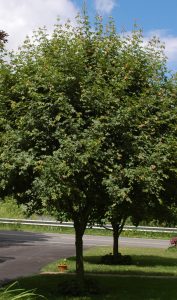 under utility lines. Hedge maple has beautiful green summer foliage that is free of
ailments. Fall color is yellow to yellow-green in color. Branches often develop very
low to the ground, providing excellent cover for wildlife, though it can easily be
trimmed up if desired. Hedge maple is really not too picky of soils; though it prefers
rich, well-drained soil, it grows well in compacted and alkaline soils. It also tolerates
severe pruning and has often been used as a hedge and even walls, especially in Europe.
Hedge maple is one of the tougher maples, which is underutilized in the U.S. It has
few problems and is very urban tolerant. Golden leaf and variegated leaf forms are
available.
under utility lines. Hedge maple has beautiful green summer foliage that is free of
ailments. Fall color is yellow to yellow-green in color. Branches often develop very
low to the ground, providing excellent cover for wildlife, though it can easily be
trimmed up if desired. Hedge maple is really not too picky of soils; though it prefers
rich, well-drained soil, it grows well in compacted and alkaline soils. It also tolerates
severe pruning and has often been used as a hedge and even walls, especially in Europe.
Hedge maple is one of the tougher maples, which is underutilized in the U.S. It has
few problems and is very urban tolerant. Golden leaf and variegated leaf forms are
available.
Exposure: Full sun or light shade
Soil: Tolerant of most soils
Hardiness: USDA Zones 5 to 8
| Icon | Icon Description |
|---|---|
 |
Drought Resistant: After initial establishment period (up to two years), plant can withstand short-term drought. |
Hornbeam
Carnipus species 
The genus Carnipus includes the native C. caroliniana (American hornbeam) and C. betulus (common in the trade. American hornbeam is a slow-growing, understory tree with an attractive globular form. It typically grows 20 to 35 feet tall. The European hornbeam grows in full sun to part shade and needs little pruning when grown as a tree, but responds well to hard pruning if grown as a hedge; it can grow to 40 to 60 feet tall with a pyramidal to oval-rounded crown, but is usually smaller when grown in Oklahoma. Both trees produce flowers as separate male and female catkins, with the female catkins giving way to distinctive clusters of winged nutlets. Leaves are dark green and can produce respectable shades of yellow, orange and red in fall. Trunks have smooth gray bark and distinctive muscle-like fluting. Upright, columnar forms are available.
Exposure: Full sun to light shade
Soil: Well drained
Hardiness: USDA Zones 3 to 9
| Icon | Icon Description |
|---|---|
 |
Native: Plant indigenous to the continental U.S. or a cultivar or hybrid derived from native plants. |
 |
Wildscape: Plant possesses one or more characteristics ideal for habitation by birds, butterflies or other animals. |
Indian Cherry
Frangula caroliniana
Indian cherry is a small tree (or large, multi-stemmed shrub) that grows 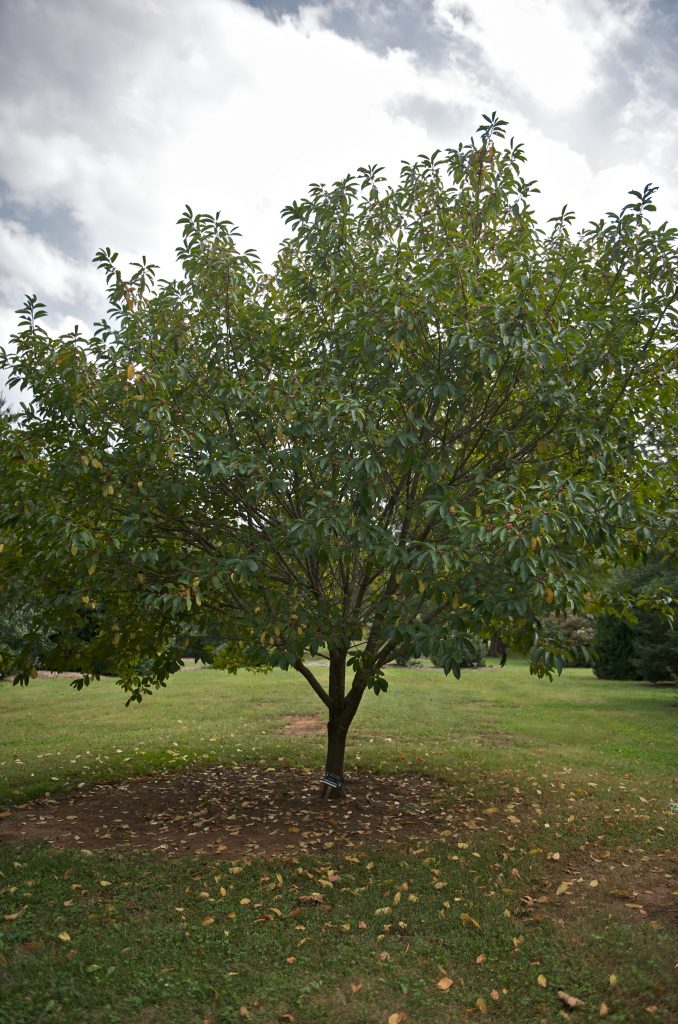 to 20 feet tall with a rounded to spreading canopy. It is native to the eastern and
southeastern U.S., making it more desirable over its European cousins. The foliage
is dark, lustrous green all summer and turns yellow to orange yellow in the fall.
Probably its greatest asset is the colorful fruits that develop late summer/fall that
turn red, then black as they mature. These beautiful, sweet fruit also attract several
species of birds and can be used to make jams and jellies.
to 20 feet tall with a rounded to spreading canopy. It is native to the eastern and
southeastern U.S., making it more desirable over its European cousins. The foliage
is dark, lustrous green all summer and turns yellow to orange yellow in the fall.
Probably its greatest asset is the colorful fruits that develop late summer/fall that
turn red, then black as they mature. These beautiful, sweet fruit also attract several
species of birds and can be used to make jams and jellies.
Exposure: Full sun to part shade
Soil: Well drained
Hardiness: USDA Zones 5 to 9
| Icon | Icon Description |
|---|---|
 |
Native: Plant indigenous to the continental U.S. or a cultivar or hybrid derived from native plants. |
 |
Wildscape: Plant possesses one or more characteristics ideal for habitation by birds, butterflies or other animals. |
Japanese Zelkova
Zelkova serrata
Zelkova serrata is a deciduous tree with a vase-shaped habit that typically grows
50  to 80 feet tall and most often occurs in rich, moist woods and hillsides and moist
stream banks. It is noted for its graceful shape, clean foliage, attractive bark and
resistance to Dutch elm disease. Zelkova is often substituted for American elm (Ulmus
americana) because of its resistance to Dutch elm disease. Cultivars from the Chinese
cousin are also available. Some notable cultivars: ‘Schmidtlow’ Wireless® (25 feet
high and 35 feetwide); ‘Ogon’ (‘Bright Park’) (golden yellow leaves, coral stems);
‘Musashino’ (narrow upright 45 feet high, but only 20 feet wide); and ‘JFS-KW1’ City
Sprite™ (compact, dense, semi-dwarf 25 feet high and 20 feet wide).
to 80 feet tall and most often occurs in rich, moist woods and hillsides and moist
stream banks. It is noted for its graceful shape, clean foliage, attractive bark and
resistance to Dutch elm disease. Zelkova is often substituted for American elm (Ulmus
americana) because of its resistance to Dutch elm disease. Cultivars from the Chinese
cousin are also available. Some notable cultivars: ‘Schmidtlow’ Wireless® (25 feet
high and 35 feetwide); ‘Ogon’ (‘Bright Park’) (golden yellow leaves, coral stems);
‘Musashino’ (narrow upright 45 feet high, but only 20 feet wide); and ‘JFS-KW1’ City
Sprite™ (compact, dense, semi-dwarf 25 feet high and 20 feet wide).
Exposure: Full sun to part shade
Soil: Tolerant of most soils
Hardiness: USDA Zones 5 to 8
| Icon | Icon Description |
|---|---|
 |
Drought Resistant: After initial establishment period (up to two years), plant can withstand short-term drought. |
Jujube or Chinese Date
Ziziphus jujuba
Jujube, also known as Chinese date, is an excellent small- to 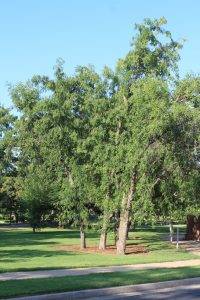 medium-sized tree with shiny green foliage in summer and yellow leaves in fall. The
naturally drooping tree is graceful, ornamental and often thorny with branches growing
in a zig-zag pattern. Jujube can grow to about 15 to 30 feet high. It makes a great
landscape tree with the added benefit of edible fruits. Commonly grown cultivars include
‘Li’ and ‘Lang.’ Fruit are round to elongate and mature from green to red, when they
have a sweet, crisp flesh somewhat similar to an apple. After maturing to red or reddish
brown, the fruits wrinkle and take on the appearance of a date.
medium-sized tree with shiny green foliage in summer and yellow leaves in fall. The
naturally drooping tree is graceful, ornamental and often thorny with branches growing
in a zig-zag pattern. Jujube can grow to about 15 to 30 feet high. It makes a great
landscape tree with the added benefit of edible fruits. Commonly grown cultivars include
‘Li’ and ‘Lang.’ Fruit are round to elongate and mature from green to red, when they
have a sweet, crisp flesh somewhat similar to an apple. After maturing to red or reddish
brown, the fruits wrinkle and take on the appearance of a date.
Exposure: Full sun to part shade
Soil: Prefers moist, well drained, acidic, but is adaptable
Hardiness: USDA Zones 4 to 9
| Icon | Icon Description |
|---|---|
 |
Wildscape: Plant possesses one or more characteristics ideal for habitation by birds, butterflies or other animals. |
 |
Drought Resistant: After initial establishment period (up to two years), plant can withstand short-term drought. |
 |
Collector's Choice: This plant will do well in Oklahoma but may need special placement or a little extra care. It will be very rewarding and impressive in the garden. |
Kentucky Coffee Tree
Gymnocladus dioica
Kentucky coffee tree is an Oklahoma native, growing to 60 feet tall.  It is very heat and drought tolerant and does well on high pH soils. Although it has
few branches when young, it matures to a majestic and beautiful tree with large seed
pods, which add winter interest. Espresso, a male selection, also is available.
It is very heat and drought tolerant and does well on high pH soils. Although it has
few branches when young, it matures to a majestic and beautiful tree with large seed
pods, which add winter interest. Espresso, a male selection, also is available.
Exposure: Full sun
Soil: Tolerant of most soils
Hardiness: USDA Zone 4
| Icon | Icon Description |
|---|---|
 |
Native: Plant indigenous to the continental U.S. or a cultivar or hybrid derived from native plants. |
 |
Wildscape: Plant possesses one or more characteristics ideal for habitation by birds, butterflies or other animals. |
 |
Drought Resistant: After initial establishment period (up to two years), plant can withstand short-term drought. |
Limber Pine
Pinus flexilis ‘Vanderwolf’s Pyramid’
‘Vanderwolf’s Pyramid’ limber pine is an evergreen tree with a pyramidal habit that
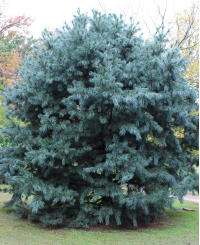 typically grows 20 to 30 feet tall and about 10 to 15 feet wide. The specific epithet
and common name is in reference to the flexible (limber) branchlets/twigs. ‘Vanderwolf’s
Pyramid’ is noted for its closely spaced, twisted, silvery blue green needles. Limber
pine is generally considered to be an adaptable, low-maintenance tree with few problems.
Limber pine is native to North America and is considered resistant to pine wilt disease.
typically grows 20 to 30 feet tall and about 10 to 15 feet wide. The specific epithet
and common name is in reference to the flexible (limber) branchlets/twigs. ‘Vanderwolf’s
Pyramid’ is noted for its closely spaced, twisted, silvery blue green needles. Limber
pine is generally considered to be an adaptable, low-maintenance tree with few problems.
Limber pine is native to North America and is considered resistant to pine wilt disease.
Exposure: Full sun to part shade
Soil: Tolerant of most soils
Hardiness: USDA Zones 4 to 7
| Icon | Icon Description |
|---|---|
 |
Native: Plant indigenous to the continental U.S. or a cultivar or hybrid derived from native plants. |
 |
Wildscape: Plant possesses one or more characteristics ideal for habitation by birds, butterflies or other animals. |
 |
Drought Resistant: After initial establishment period (up to two years), plant can withstand short-term drought. |
Oklahoma Redbud
Cercis canadensis var. texensis ‘Oklahoma’
 A cultivar of Oklahoma’s state tree, ‘Oklahoma’ was discovered in the Arbuckle Mountains
and was selected for the incredible magenta flowers that cover the tree in early spring.
When the flowers fade, heart-shaped leaves emerge with a beautiful glossy sheen. ‘Oklahoma’
redbud can withstand full sun, and their small size (15 to 25 feet high) makes them
perfect for use under utility lines. They tolerate a wide range of conditions, but
do best in well-drained soils. ‘Oklahoma’ is one of the most beautiful native trees
and is perfect for small yards needing a splash of color or grouped together where
space allows.
A cultivar of Oklahoma’s state tree, ‘Oklahoma’ was discovered in the Arbuckle Mountains
and was selected for the incredible magenta flowers that cover the tree in early spring.
When the flowers fade, heart-shaped leaves emerge with a beautiful glossy sheen. ‘Oklahoma’
redbud can withstand full sun, and their small size (15 to 25 feet high) makes them
perfect for use under utility lines. They tolerate a wide range of conditions, but
do best in well-drained soils. ‘Oklahoma’ is one of the most beautiful native trees
and is perfect for small yards needing a splash of color or grouped together where
space allows.
Exposure: Full sun to part shade
Soil: Well drained
Hardiness: USDA Zone 6
| Icon | Icon Description |
|---|---|
 |
Native: Plant indigenous to the continental U.S. or a cultivar or hybrid derived from native plants. |
 |
Wildscape: Plant possesses one or more characteristics ideal for habitation by birds, butterflies or other animals. |
Pawpaw
Asimina triloba
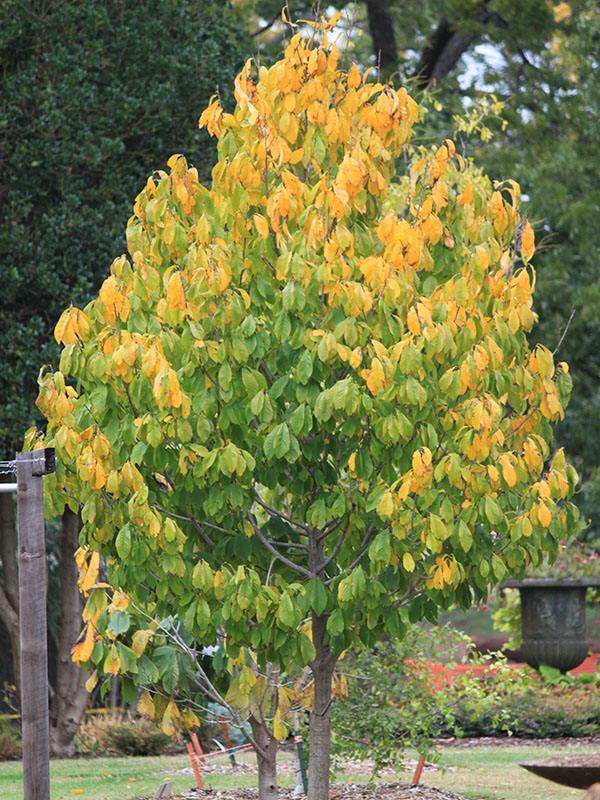 Pawpaw is a native, understory tree. It is native to Canada and the eastern U.S. where
it grows in deep shade to full sunlight in moist, nutrient-rich forests. It will tolerate
occasional wet or moist conditions but prefers good drainage and acidic soil. Flowers
are purplish-brown flowers, have both male and female parts, but are self-incompatible.
Trees require cross pollination so at least 2 and preferably 3 different varieties
should be grown. Trees are pollinated by insects other than bees and must be planted
close together. In late summer to early fall, edible, sweet-tasting and custard-like
fruit develop. Harvesting can be difficult with competition from ambitious wildlife.
The leaves turn a yellow color in the fall and provide interest. Pawpaw attracts butterflies,
pollinators, small mammals and songbirds, making it a good addition to a butterfly,
pollinator or rain garden. It is an easy-to-grow fruit tree for children’s gardens.
Pawpaw is a native, understory tree. It is native to Canada and the eastern U.S. where
it grows in deep shade to full sunlight in moist, nutrient-rich forests. It will tolerate
occasional wet or moist conditions but prefers good drainage and acidic soil. Flowers
are purplish-brown flowers, have both male and female parts, but are self-incompatible.
Trees require cross pollination so at least 2 and preferably 3 different varieties
should be grown. Trees are pollinated by insects other than bees and must be planted
close together. In late summer to early fall, edible, sweet-tasting and custard-like
fruit develop. Harvesting can be difficult with competition from ambitious wildlife.
The leaves turn a yellow color in the fall and provide interest. Pawpaw attracts butterflies,
pollinators, small mammals and songbirds, making it a good addition to a butterfly,
pollinator or rain garden. It is an easy-to-grow fruit tree for children’s gardens.
Exposure: Full sun to shade
Soil: Moist, well-drained, occasionally wet
Hardiness: USDA Zones 5 to 9
| Icon | Icon Description |
|---|---|
 |
Native: Plant indigenous to the continental U.S. or a cultivar or hybrid derived from native plants. |
 |
Wildscape: Plant possesses one or more characteristics ideal for habitation by birds, butterflies or other animals. |
 |
Collector's Choice: This plant will do well in Oklahoma but may need special placement or a little extra care. It will be very rewarding and impressive in the garden. |
Persian Parrotia
Parrotia persica
Persian parrotia is a small tree reaching only 20 to 30 feet tall and can  spread almost as wide. Interesting deep-maroon flowers appear in late winter. Leaves
have a reddish color when appearing in spring and change to a lustrous green in summer
and can be a brilliant yellow or orange in fall. The bark exfoliates into patches
of green, cream and gray, adding to the year-round interest of this tree. It is very
heat and drought tolerant once established, but appreciates some protection from the
afternoon sun.
spread almost as wide. Interesting deep-maroon flowers appear in late winter. Leaves
have a reddish color when appearing in spring and change to a lustrous green in summer
and can be a brilliant yellow or orange in fall. The bark exfoliates into patches
of green, cream and gray, adding to the year-round interest of this tree. It is very
heat and drought tolerant once established, but appreciates some protection from the
afternoon sun.
Exposure: Part shade
Soil: Moist, well drained
Hardiness: USDA Zone 5
| Icon | Icon Description |
|---|---|
 |
Wildscape: Plant possesses one or more characteristics ideal for habitation by birds, butterflies or other animals. |
 |
Drought Resistant: After initial establishment period (up to two years), plant can withstand short-term drought. |
 |
Collector's Choice: This plant will do well in Oklahoma but may need special placement or a little extra care. It will be very rewarding and impressive in the garden. |
Redbud
Cercis
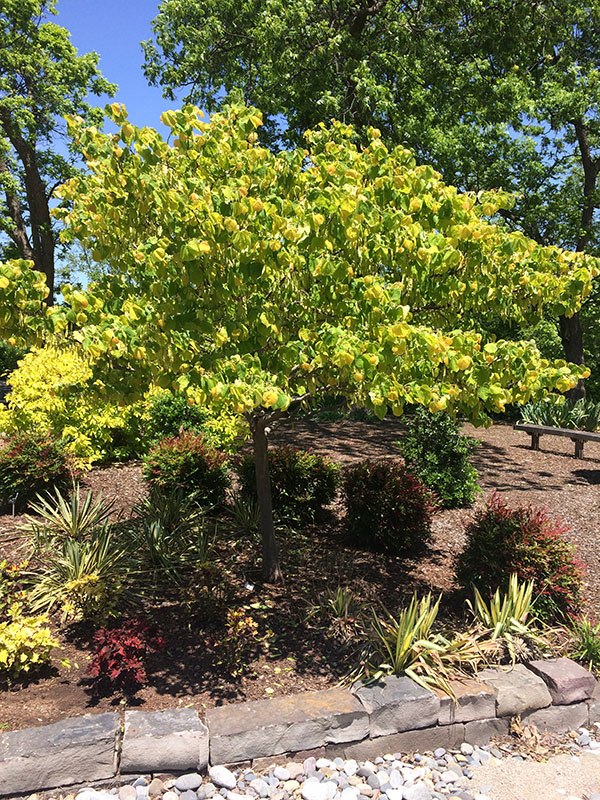 Cercis species, commonly called redbud, are found growing throughout North America, regions
of Europe, and Asia. It is an attractive, small to medium, tree growing up to 20 feet
to 30 feet, but it can sometimes grow as a multi-stemmed large shrub. Leaves are heart-shaped,
young bark is gray which contrasts nicely with the bright magenta flowers that appear
before the leaves in spring. Redbuds are often understory trees in wooded areas. It
grows in average, medium moisture, well-drained soils in full sun to part shade, but
it does best in part shade areas in our hot summers. The eastern redbud, Cercis canadensis,
is the Oklahoma state tree. There are many cultivars to choose from, but Mexican redbud
and the Chinese redbuds are also worthy small trees.
Cercis species, commonly called redbud, are found growing throughout North America, regions
of Europe, and Asia. It is an attractive, small to medium, tree growing up to 20 feet
to 30 feet, but it can sometimes grow as a multi-stemmed large shrub. Leaves are heart-shaped,
young bark is gray which contrasts nicely with the bright magenta flowers that appear
before the leaves in spring. Redbuds are often understory trees in wooded areas. It
grows in average, medium moisture, well-drained soils in full sun to part shade, but
it does best in part shade areas in our hot summers. The eastern redbud, Cercis canadensis,
is the Oklahoma state tree. There are many cultivars to choose from, but Mexican redbud
and the Chinese redbuds are also worthy small trees.
Exposure: Part shade is best, but tolerates full sun
Soil: Prefers moist, well-drained
Hardiness: USDA Zones 4 to 9
| Icon | Icon Description |
|---|---|
 |
Native: Plant indigenous to the continental U.S. or a cultivar or hybrid derived from native plants. |
 |
Wildscape: Plant possesses one or more characteristics ideal for habitation by birds, butterflies or other animals. |
Shantung Maple
Acer truncatum
Shantung maple is a drought-tolerant, small- to medium-sized tree  great for under power lines or in residential landscapes where there is not room for
a large tree. It grows quickly, but typically only to 30 feet high. The leaves are
star-shaped and typically emerge with an attractive purple tinge. This Asian native
can have excellent fall color ranging from yellow to orange or red.
great for under power lines or in residential landscapes where there is not room for
a large tree. It grows quickly, but typically only to 30 feet high. The leaves are
star-shaped and typically emerge with an attractive purple tinge. This Asian native
can have excellent fall color ranging from yellow to orange or red.
Exposure: Full sun
Soil: Tolerant of most soils
Hardiness: USDA Zone 4
| Icon | Icon Description |
|---|---|
 |
Wildscape: Plant possesses one or more characteristics ideal for habitation by birds, butterflies or other animals. |
 |
Drought Resistant: After initial establishment period (up to two years), plant can withstand short-term drought. |
Shumard Oak
Quercus shumardii
Shumard oak is an Oklahoma native plant that can grow to be over  100 feet tall in the wild, but typically reaches 40 to 60 feet in the landscape. Shumard
oak produces healthy green foliage even on alkaline soils, tolerates summer heat and
drought and transplants easily.
100 feet tall in the wild, but typically reaches 40 to 60 feet in the landscape. Shumard
oak produces healthy green foliage even on alkaline soils, tolerates summer heat and
drought and transplants easily.
Exposure: Full sun
Soil: Well drained
Hardiness: USDA Zone 4
| Icon | Icon Description |
|---|---|
 |
Native: Plant indigenous to the continental U.S. or a cultivar or hybrid derived from native plants. |
 |
Wildscape: Plant possesses one or more characteristics ideal for habitation by birds, butterflies or other animals. |
 |
Drought Resistant: After initial establishment period (up to two years), plant can withstand short-term drought. |
Silver Linden
Tilia tomentosa
Silver linden is a beautiful large shade tree that can grow 50 to 70 feet tall. It
is 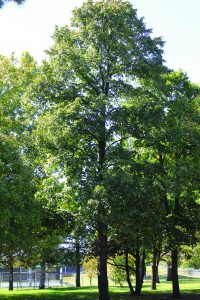 quite tolerant of high pH soils and urban conditions and is more heat tolerant than
other lindens, making it a great street or shade tree for large yards in Oklahoma.
Leaves of silver linden are dark green on the upper surface and silvery beneath, providing
an interesting effect when the wind blows; leaves can have a nice yellow fall color.
Tiny, fragrant white flowers attract bees in late June to July. Cultivars selected
for brilliant fall color as well as outstanding performance are available.
quite tolerant of high pH soils and urban conditions and is more heat tolerant than
other lindens, making it a great street or shade tree for large yards in Oklahoma.
Leaves of silver linden are dark green on the upper surface and silvery beneath, providing
an interesting effect when the wind blows; leaves can have a nice yellow fall color.
Tiny, fragrant white flowers attract bees in late June to July. Cultivars selected
for brilliant fall color as well as outstanding performance are available.
Exposure: Full sun
Soil: Moist, well drained; tolerant of high pH soils and pollution
Hardiness: USDA Zones 4 to 7
| Icon | Icon Description |
|---|---|
 |
Wildscape: Plant possesses one or more characteristics ideal for habitation by birds, butterflies or other animals. |
 |
Drought Resistant: After initial establishment period (up to two years), plant can withstand short-term drought. |
 |
Collector's Choice: This plant will do well in Oklahoma but may need special placement or a little extra care. It will be very rewarding and impressive in the garden. |
Teddybear® Southern Magnolia
Magnolia grandiflora ‘Southern Charm’
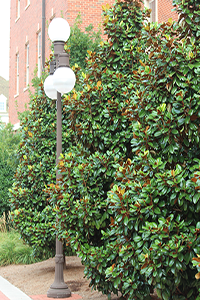 Southern magnolias are the southern belles of the evergreen plant world. The species
can reach 80 feet high and 50 feet wide and traditionally have been found on large
estates and plantations of the south, however, these are too big for many urban landscapes.
We have a solution for that though, enter ‘Southern Charm’ also known as Teddybear®.
Teddybear is a dwarf, compact version of the species. It grows about 16 to 20 feet
high and 10 to 12 feet wide in an upright pyramidal form, which makes it suitable
for smaller gardens, screens, avenues, and specimens, as well as growing in large
planters and containers. Leaves are deep green and glossy above with a dense reddish-brown
fur on the underside, thus the Teddybear name. Flowers are large, up to 8 inches across,
saucer-shaped, white, and fragrant appearing in early summer until early fall.
Southern magnolias are the southern belles of the evergreen plant world. The species
can reach 80 feet high and 50 feet wide and traditionally have been found on large
estates and plantations of the south, however, these are too big for many urban landscapes.
We have a solution for that though, enter ‘Southern Charm’ also known as Teddybear®.
Teddybear is a dwarf, compact version of the species. It grows about 16 to 20 feet
high and 10 to 12 feet wide in an upright pyramidal form, which makes it suitable
for smaller gardens, screens, avenues, and specimens, as well as growing in large
planters and containers. Leaves are deep green and glossy above with a dense reddish-brown
fur on the underside, thus the Teddybear name. Flowers are large, up to 8 inches across,
saucer-shaped, white, and fragrant appearing in early summer until early fall.
Exposure: Full sun to part shade
Soil: Moist, well-drained
Hardiness: USDA Zones 7 to 9
| Icon | Icon Description |
|---|---|
 |
Native: Plant indigenous to the continental U.S. or a cultivar or hybrid derived from native plants. |
 |
Wildscape: Plant possesses one or more characteristics ideal for habitation by birds, butterflies or other animals. |
 |
Drought Resistant: After initial establishment period (up to two years), plant can withstand short-term drought. |
Trident Maple
Acer buergerianum
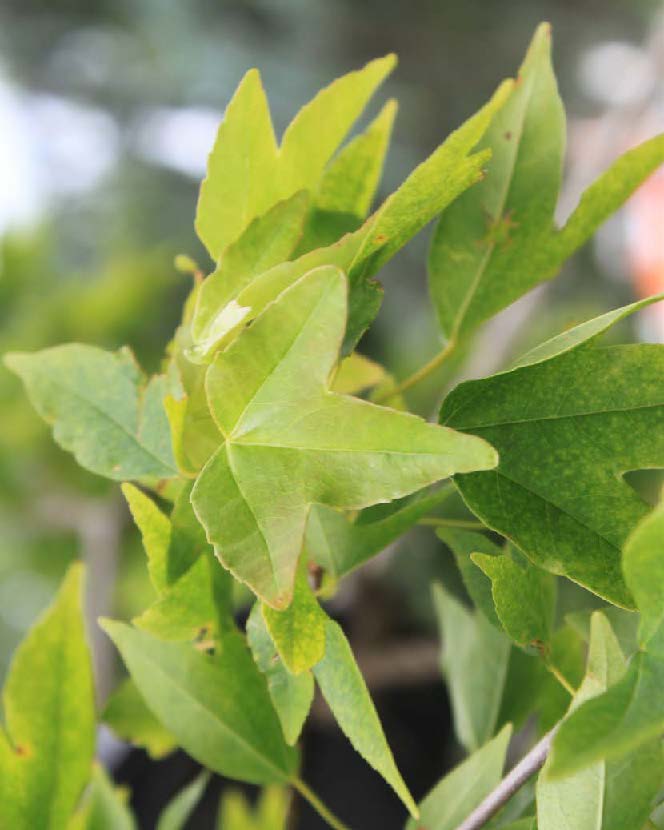 Trident maple or three-toothed maple is native to China, Korea and Japan. It is an
attractive, small, rounded, deciduous tree that typically grows rather slowly to 20
to 25 feet high. This tree tends to grow as a multi-stemmed, low-branching specimen,
but it can be pruned to a single stem. Triangular, three-lobed leaves are glossy green
above and pale green beneath. It has interesting faky bark revealing an orange brown
inner bark on mature trunks. Variable but usually attractive fall color features shades
of dark red and orange. Easily grown in average, medium moisture, well-drained soils
in full sun to part shade. Best in full sun. Tolerates some drought, soil compaction
and air pollution, making it a possible specimen for street plantings in urban areas.
No serious insect or disease problems.
Trident maple or three-toothed maple is native to China, Korea and Japan. It is an
attractive, small, rounded, deciduous tree that typically grows rather slowly to 20
to 25 feet high. This tree tends to grow as a multi-stemmed, low-branching specimen,
but it can be pruned to a single stem. Triangular, three-lobed leaves are glossy green
above and pale green beneath. It has interesting faky bark revealing an orange brown
inner bark on mature trunks. Variable but usually attractive fall color features shades
of dark red and orange. Easily grown in average, medium moisture, well-drained soils
in full sun to part shade. Best in full sun. Tolerates some drought, soil compaction
and air pollution, making it a possible specimen for street plantings in urban areas.
No serious insect or disease problems.
Exposure: Full sun to part shade
Soil: Moist, well drained
Hardiness: USDA Zones 5 to 9
Winterberry Euonymus
Euonymus bungeanus
Winterberry euonymus is a large shrub to small tree with pendulous branches and light green foliage. Flowers are yellowish-green but not showy. Fruits are pinkish
capsules, which split open at maturity revealing an orange aril (fleshy seed covering).
Fall color can be yellow to orange and red. Bark is green with a rough texture and
also is quite attractive. Winterberry grows 15 to 24 feet high and just about as wide.
It is very adaptable and quite drought tolerant. It is mostly resistant to scale insects
that are common on other euonymus species. Winterberry makes a great patio or specimen
tree.
light green foliage. Flowers are yellowish-green but not showy. Fruits are pinkish
capsules, which split open at maturity revealing an orange aril (fleshy seed covering).
Fall color can be yellow to orange and red. Bark is green with a rough texture and
also is quite attractive. Winterberry grows 15 to 24 feet high and just about as wide.
It is very adaptable and quite drought tolerant. It is mostly resistant to scale insects
that are common on other euonymus species. Winterberry makes a great patio or specimen
tree.
Exposure: Full sun to part shade
Soil: Tolerant of most soils
Hardiness: USDA Zones 4 to 7
| Icon | Icon Description |
|---|---|
 |
Drought Resistant: After initial establishment period (up to two years), plant can withstand short-term drought. |

